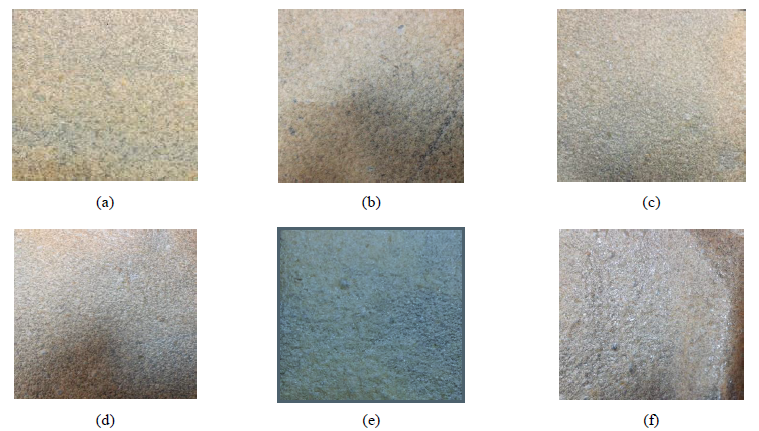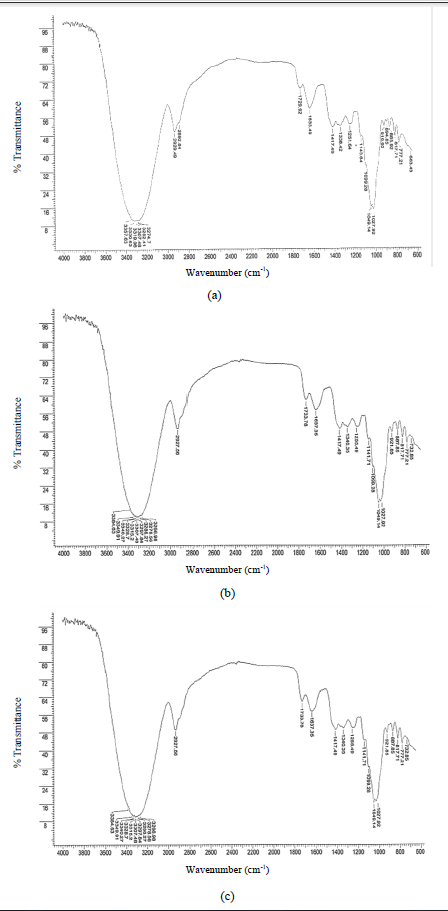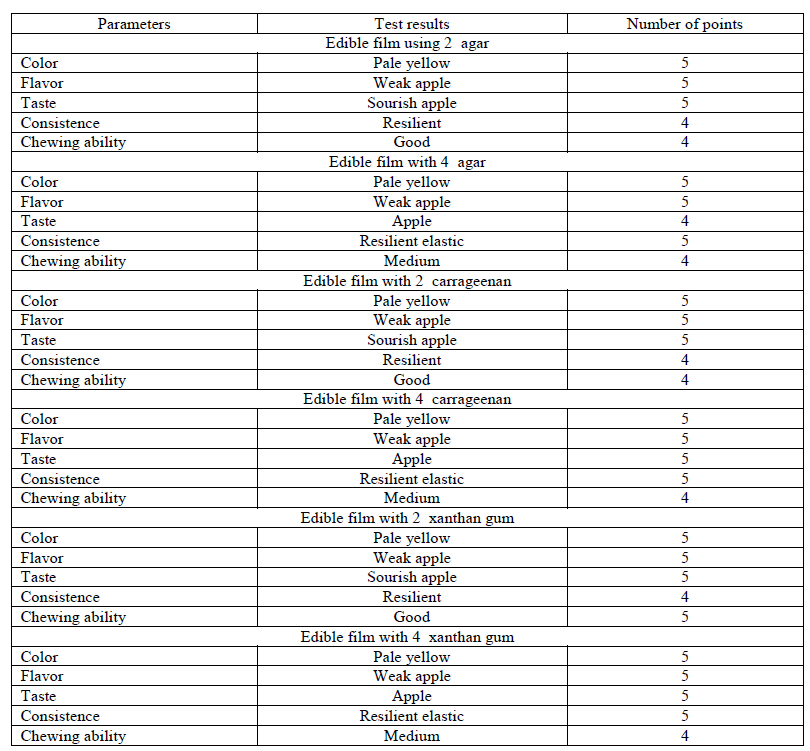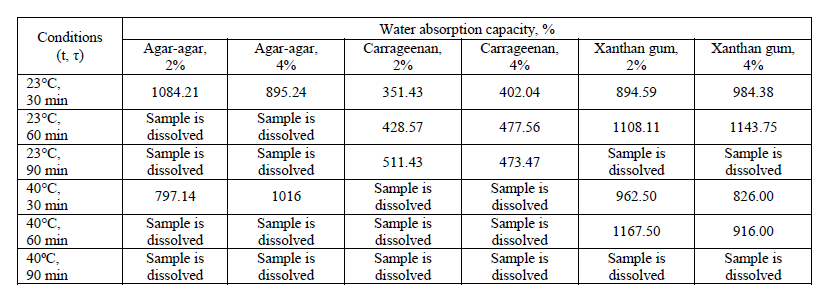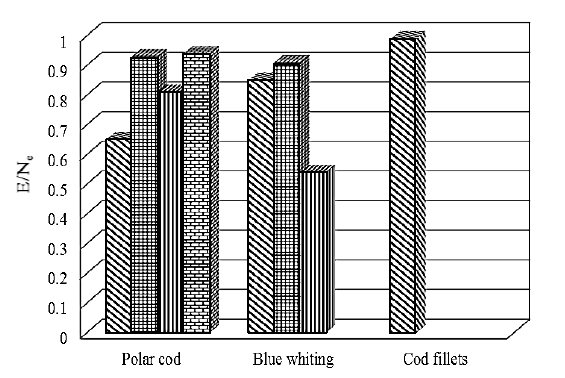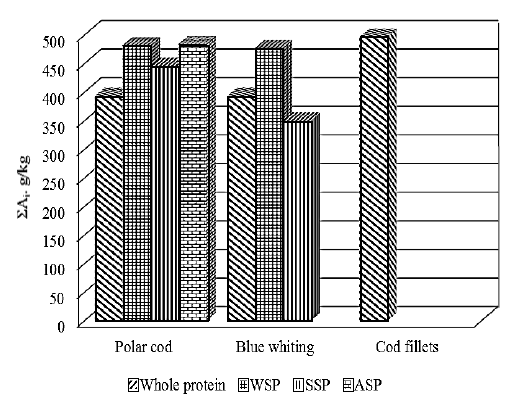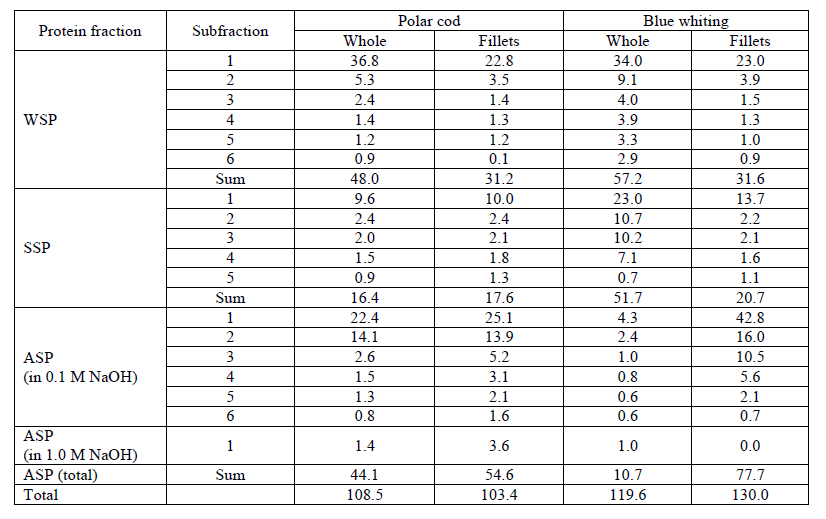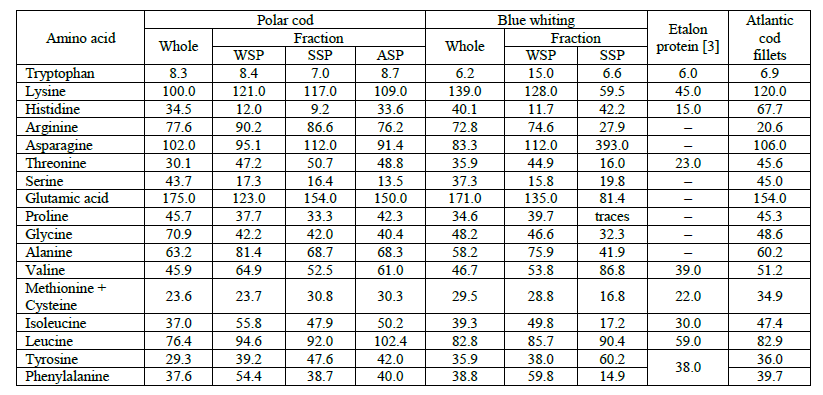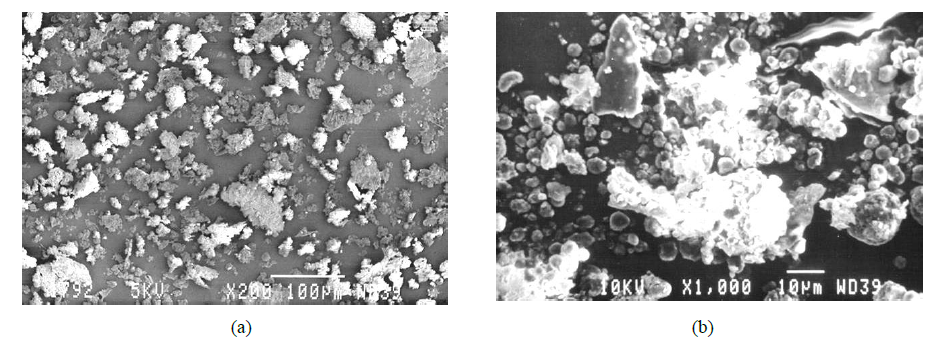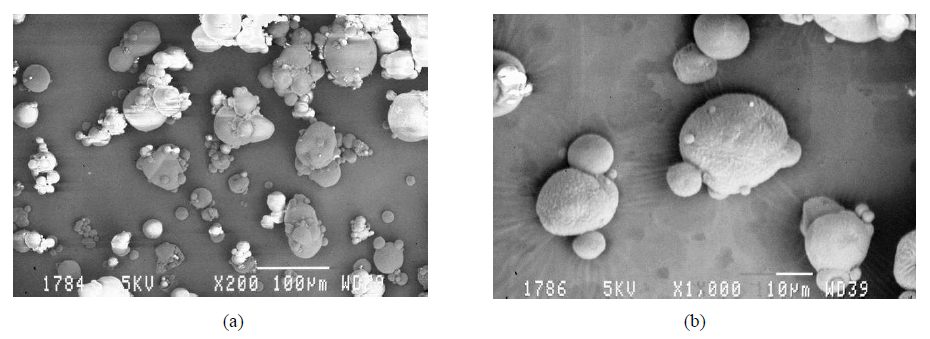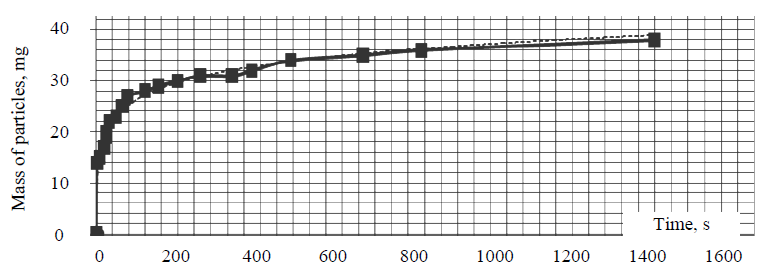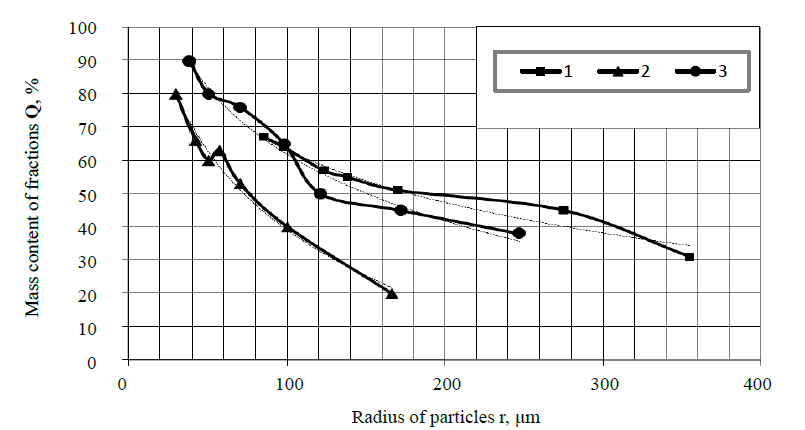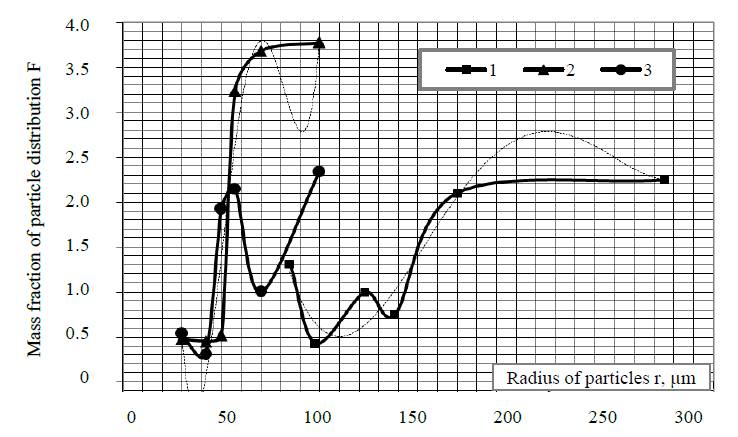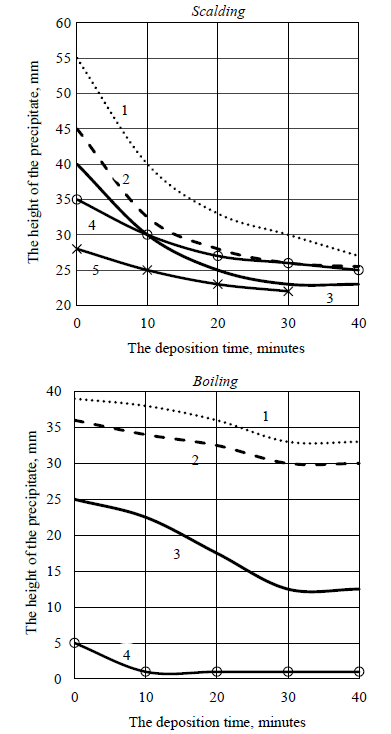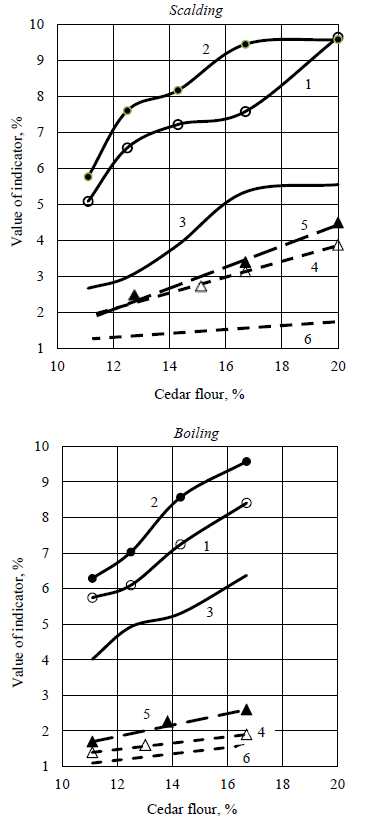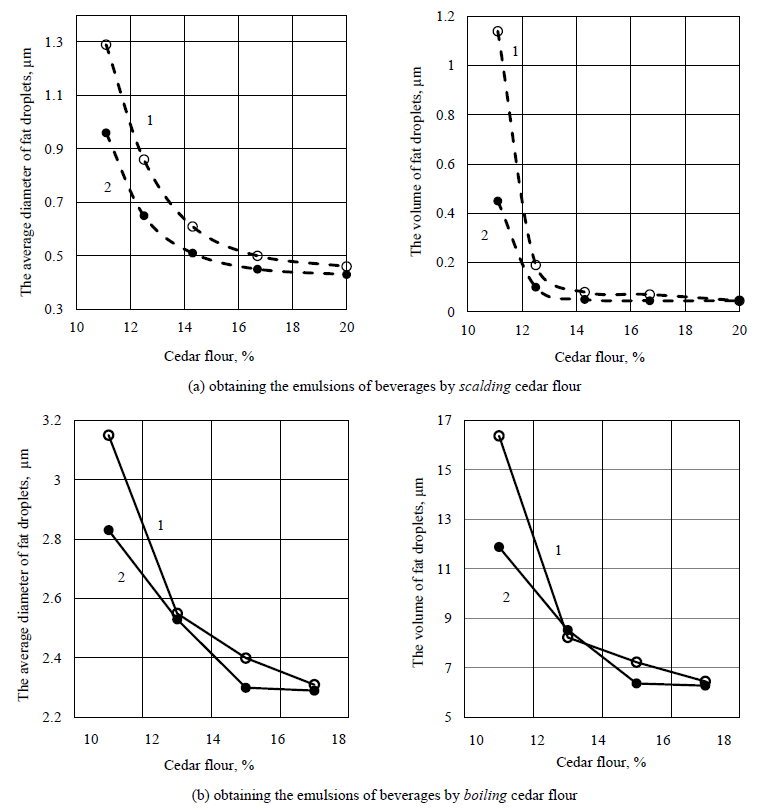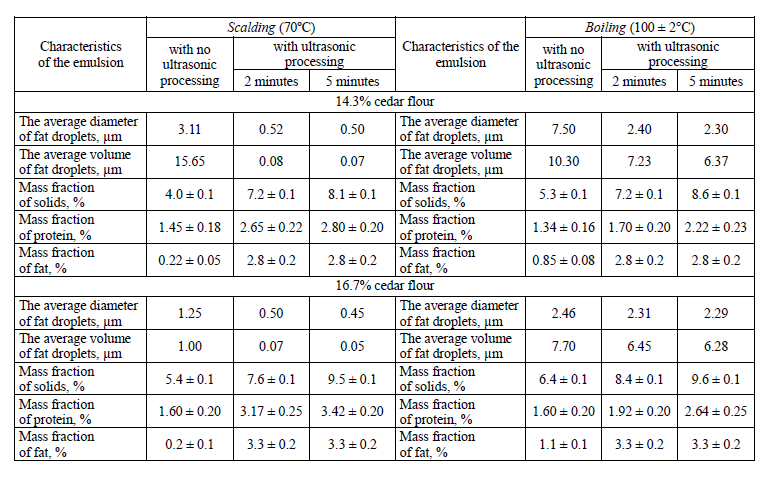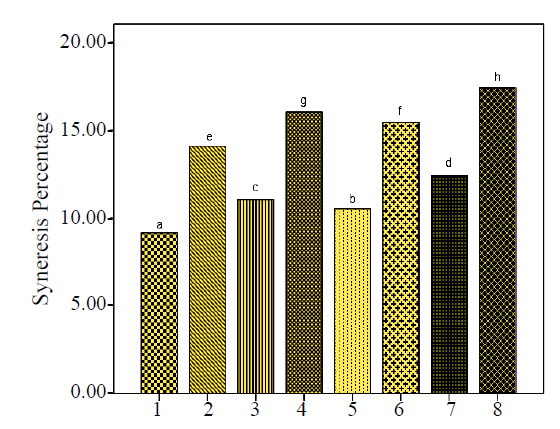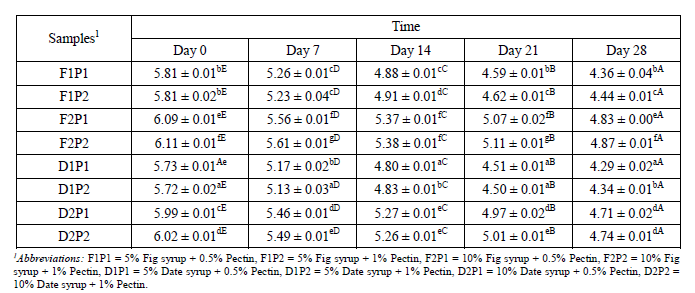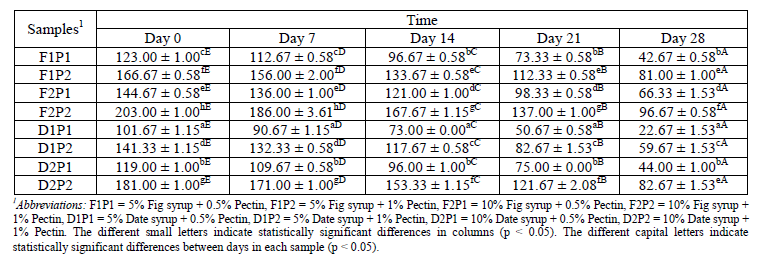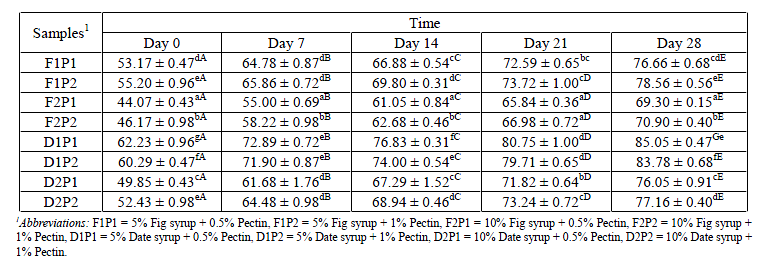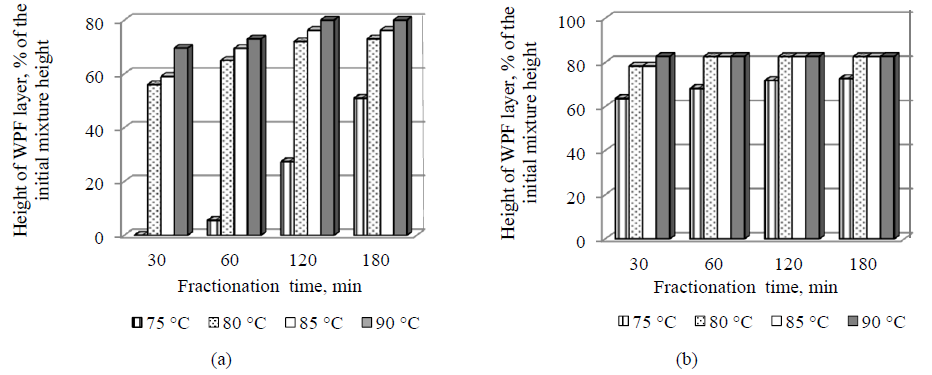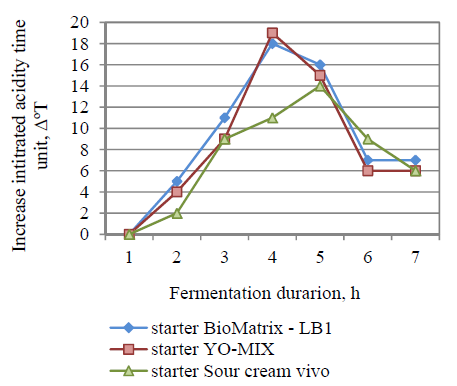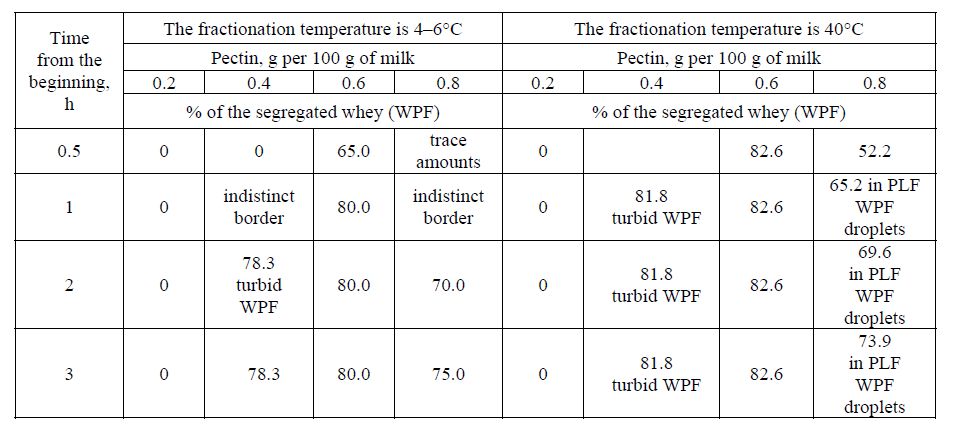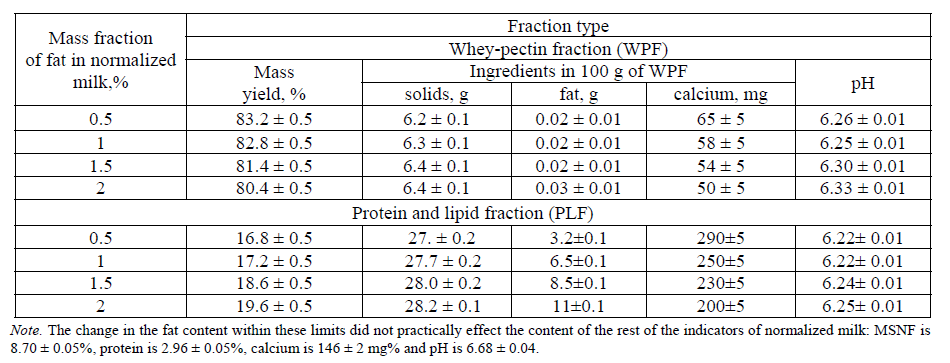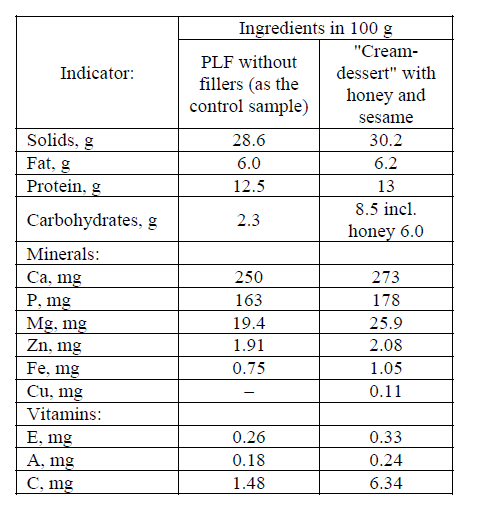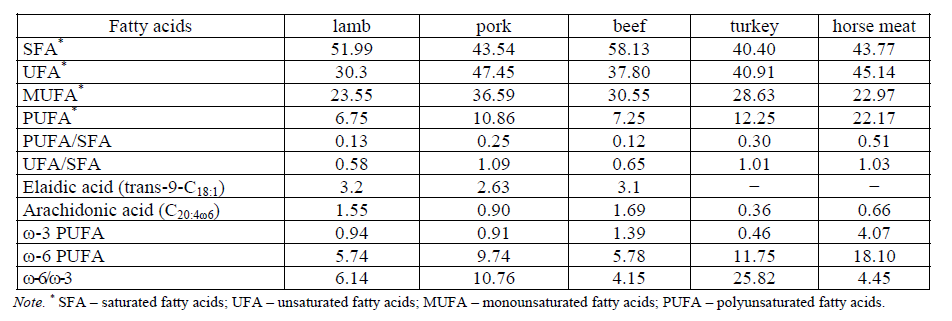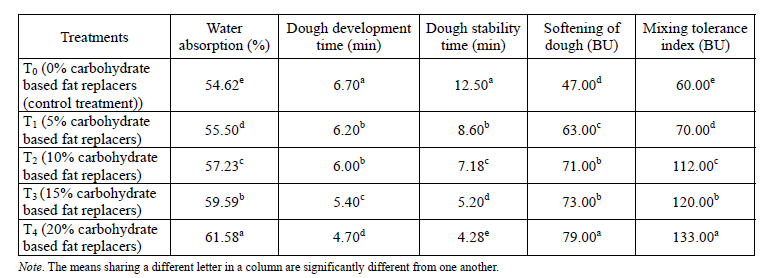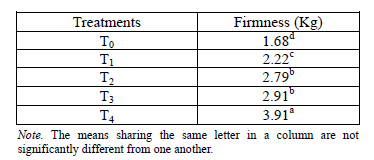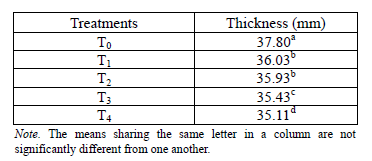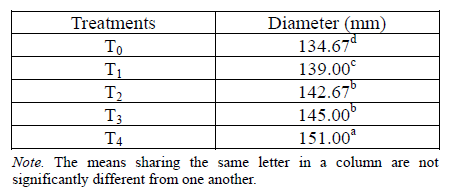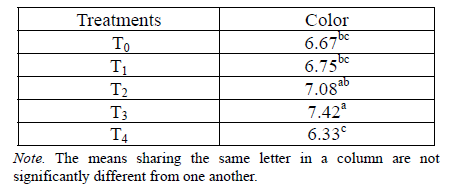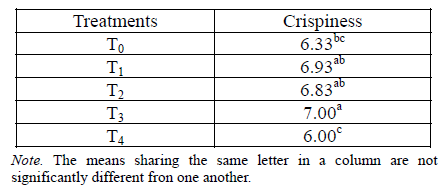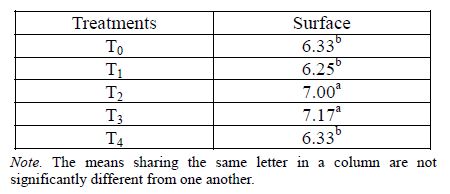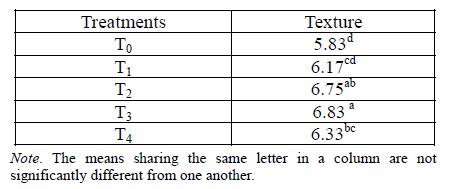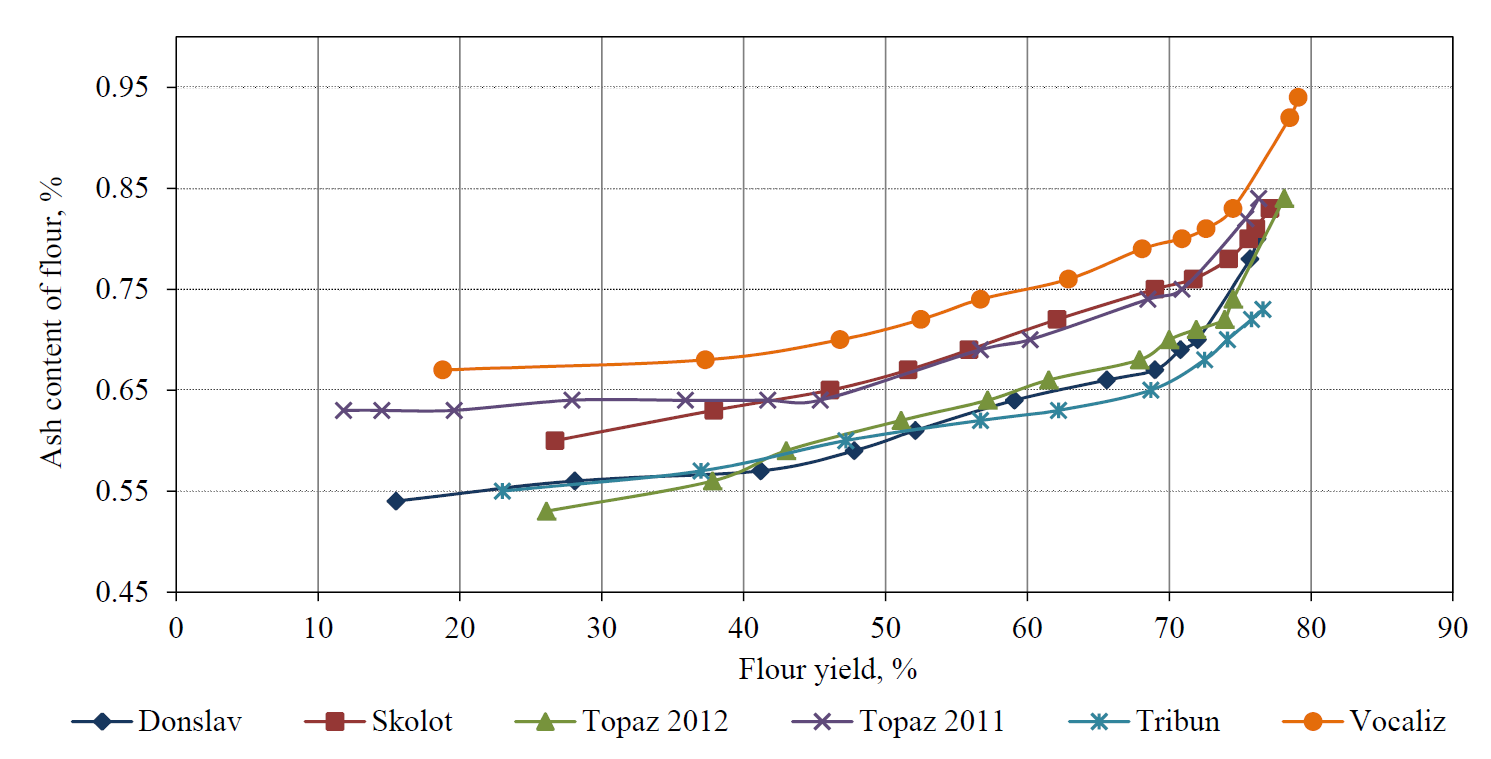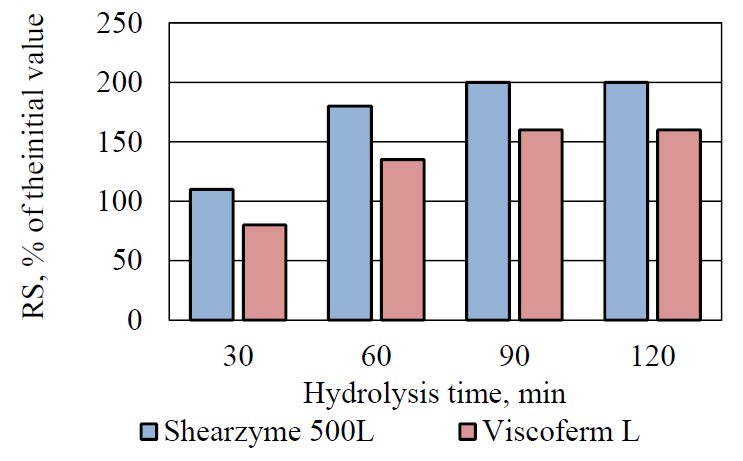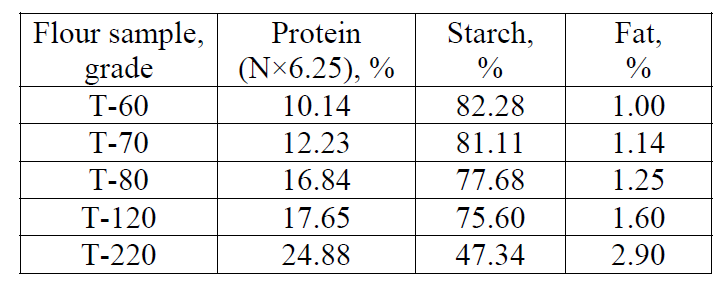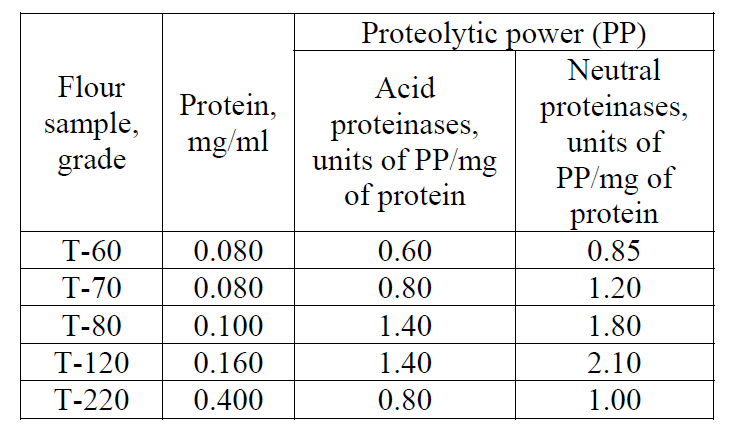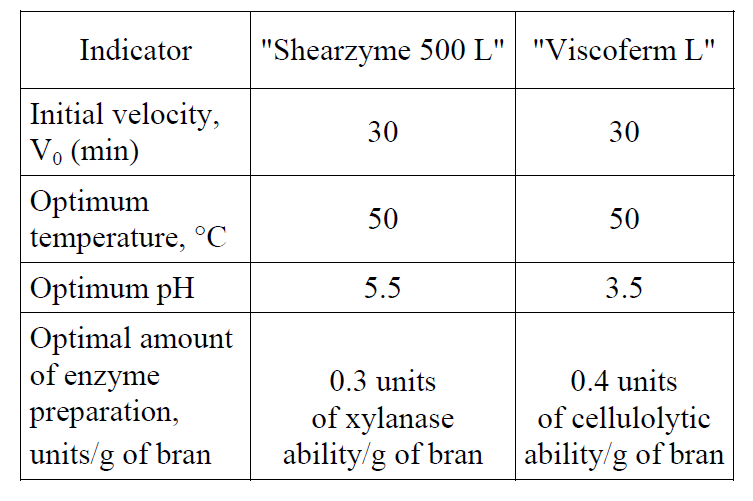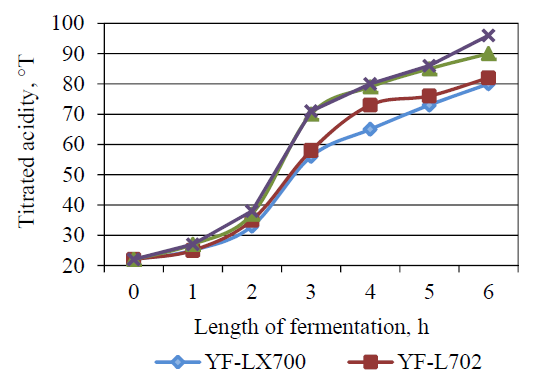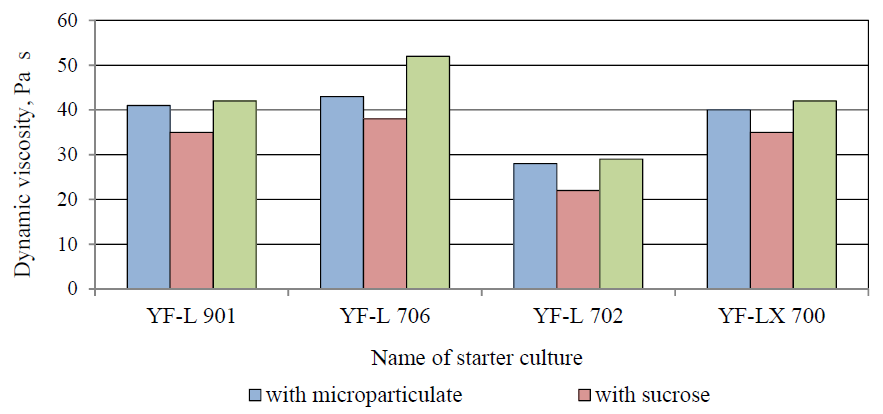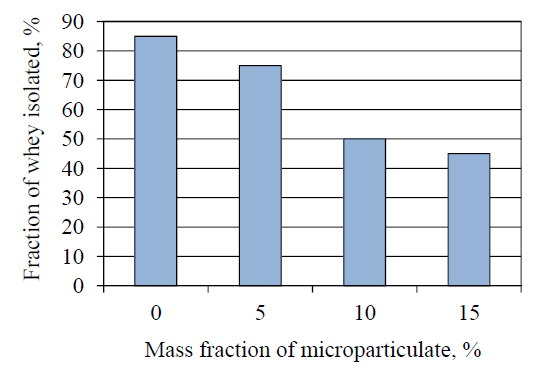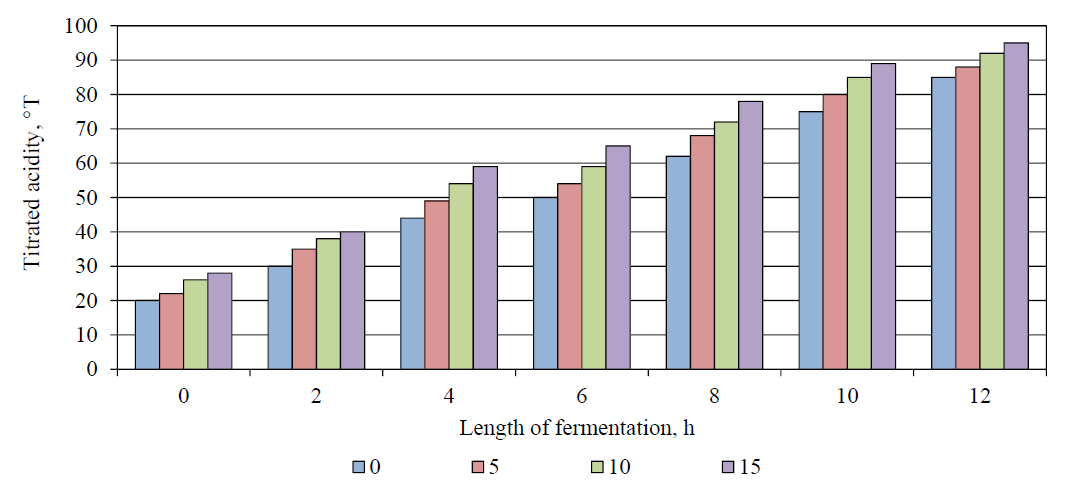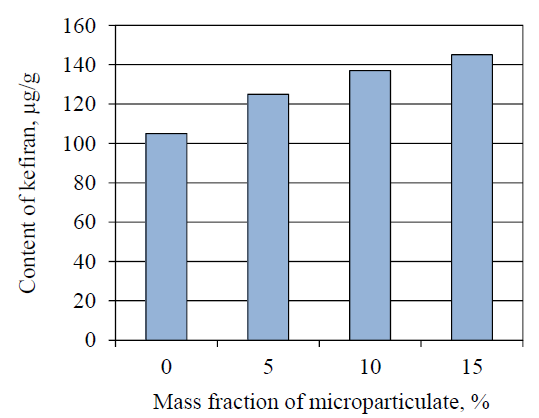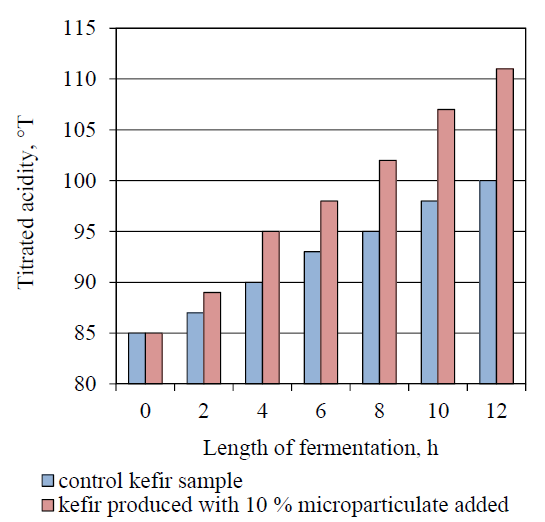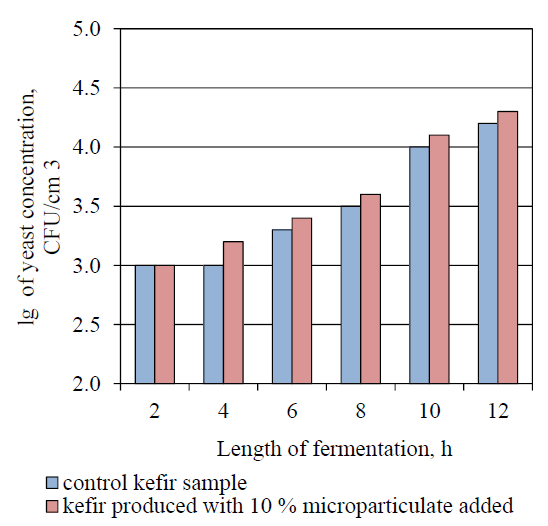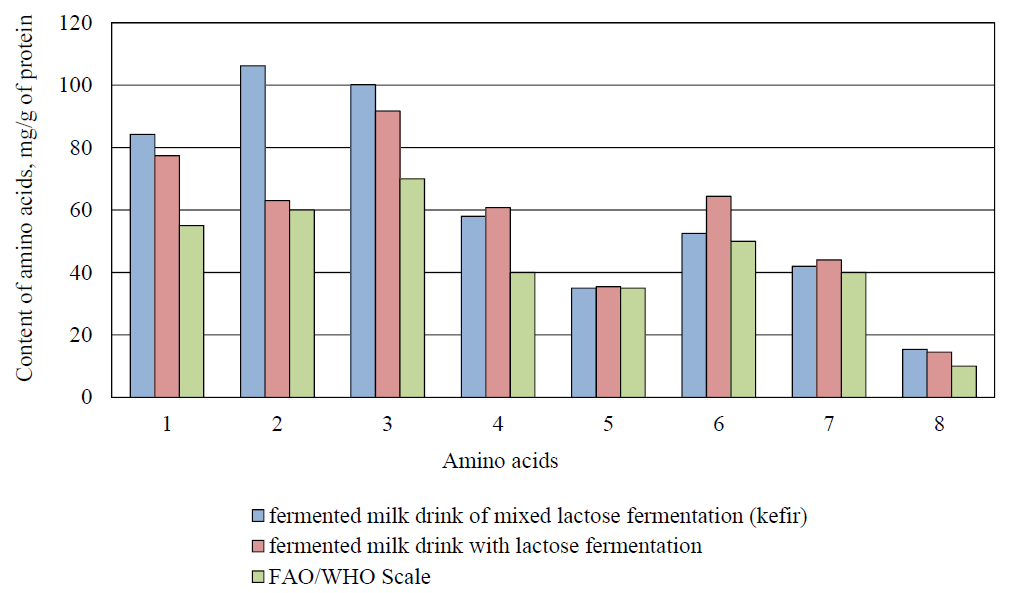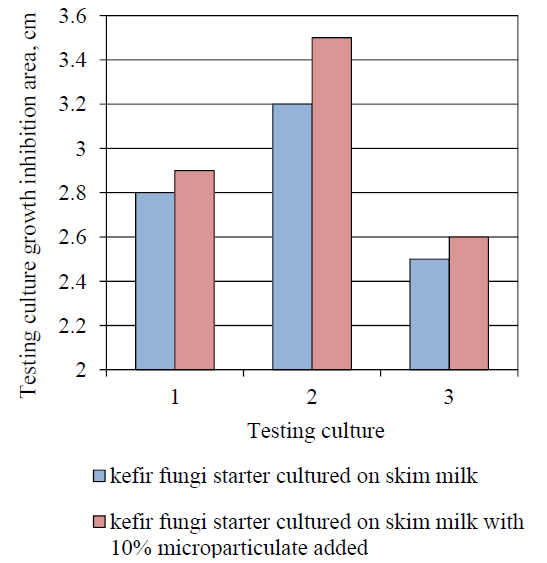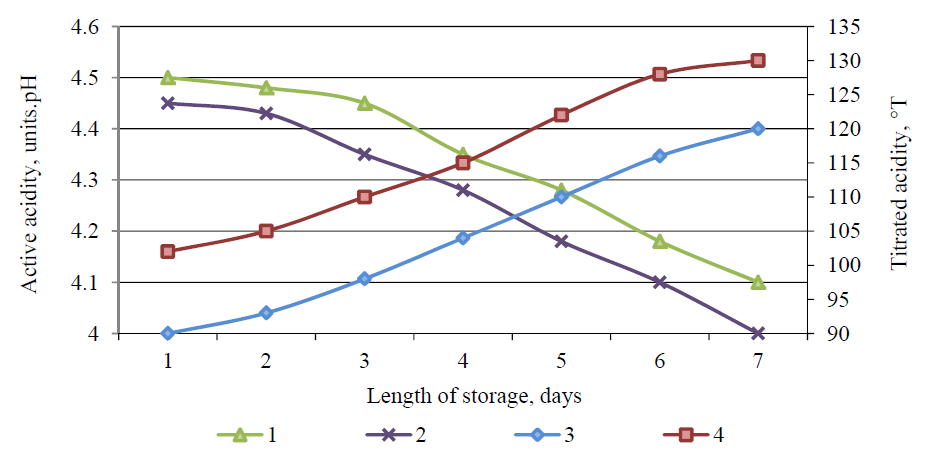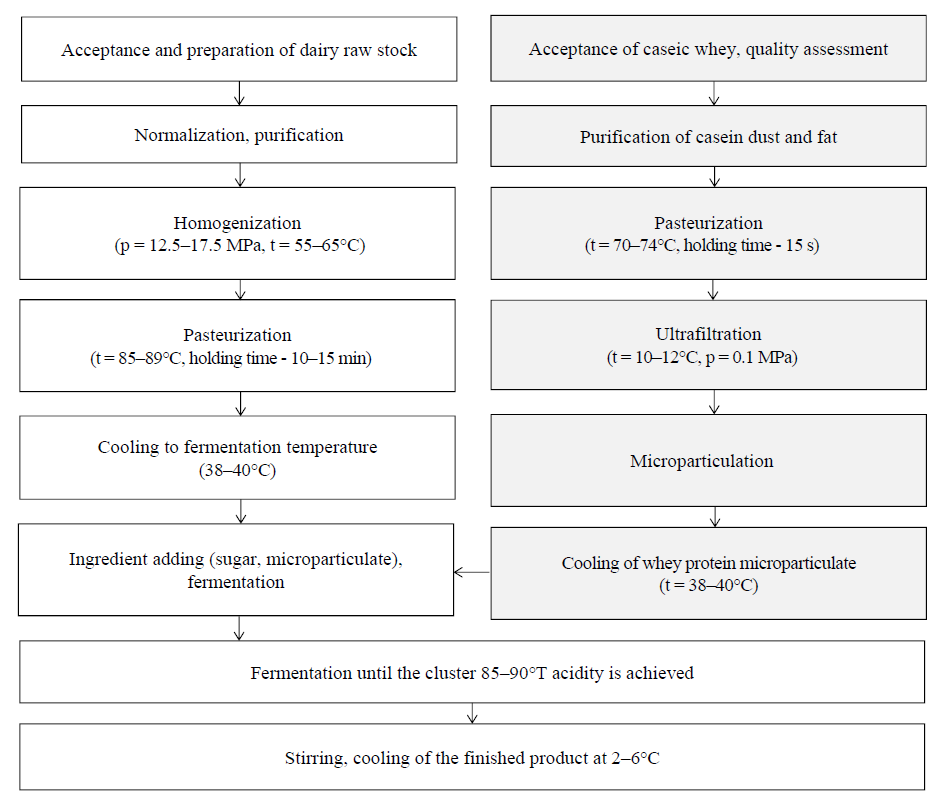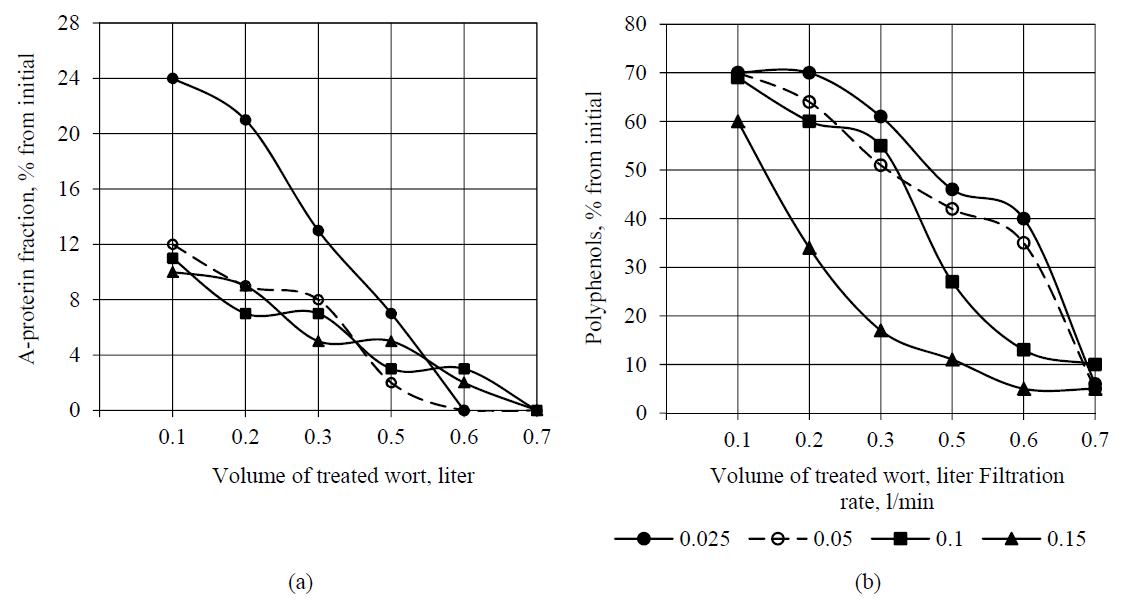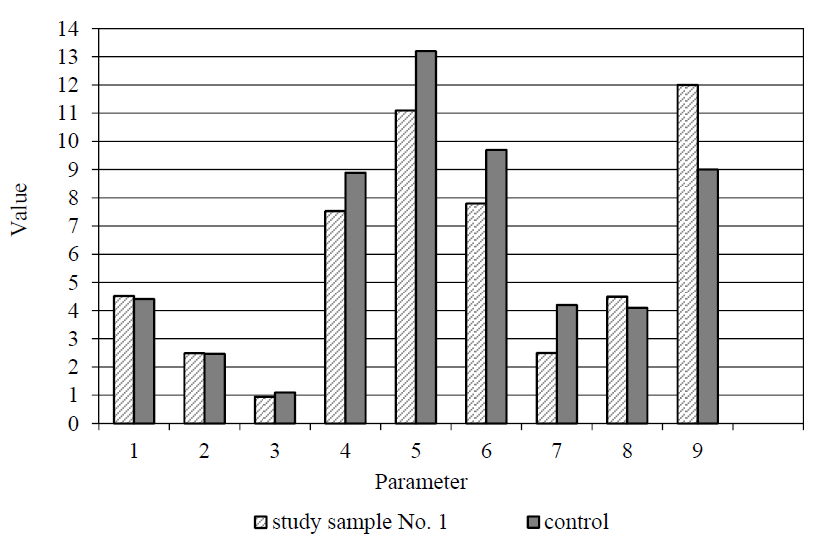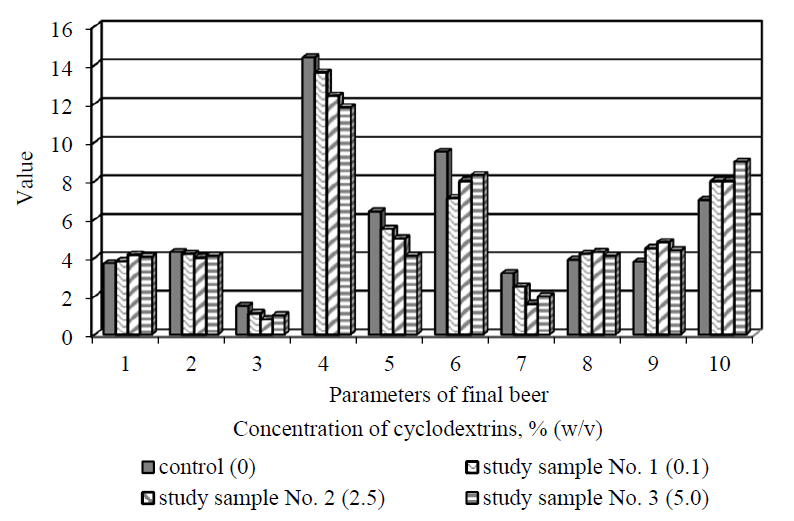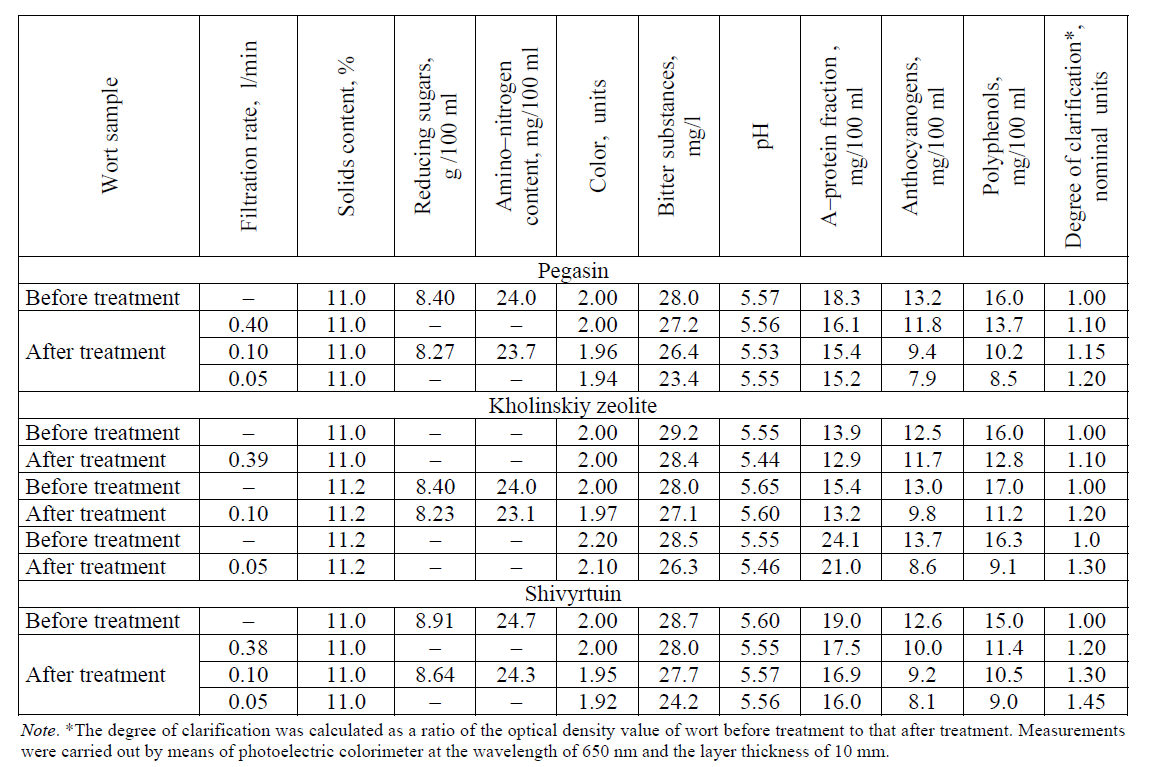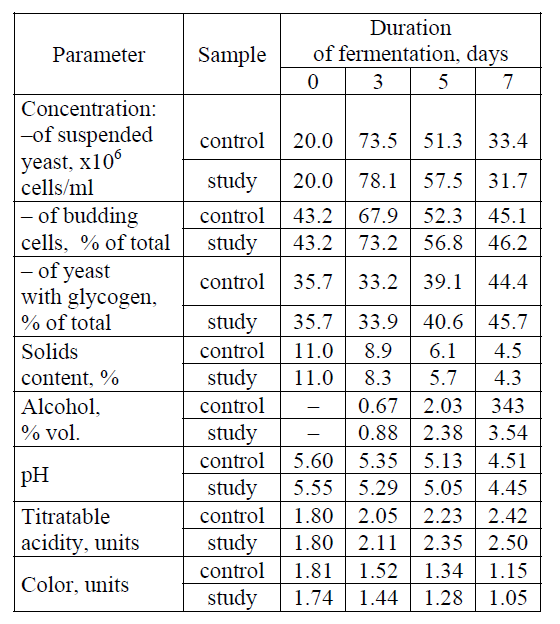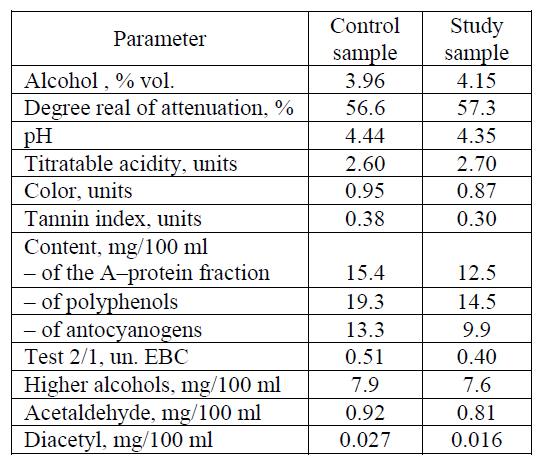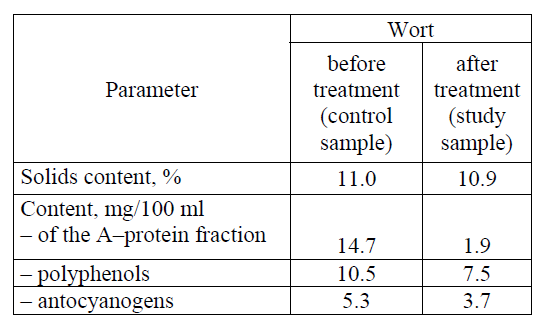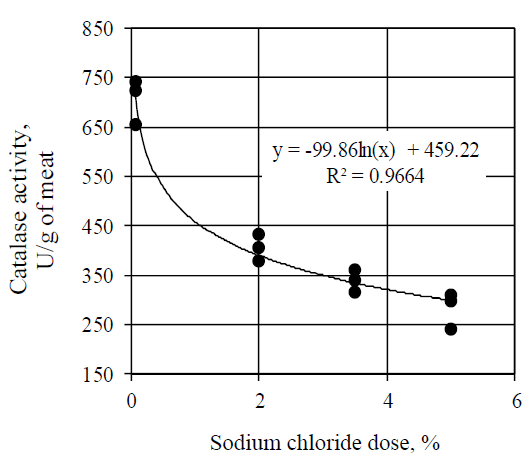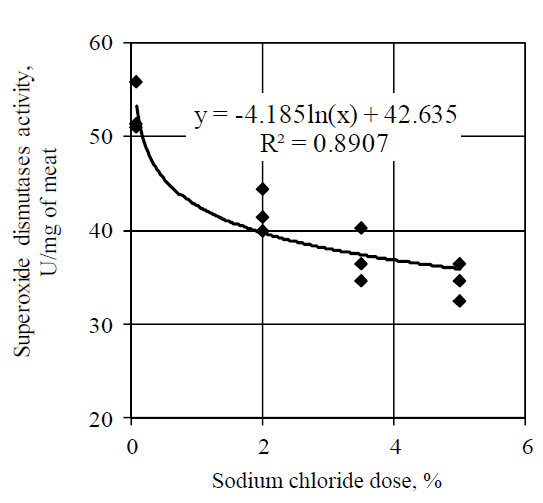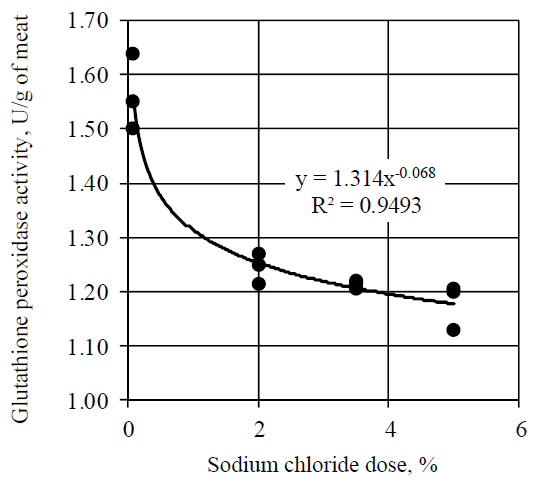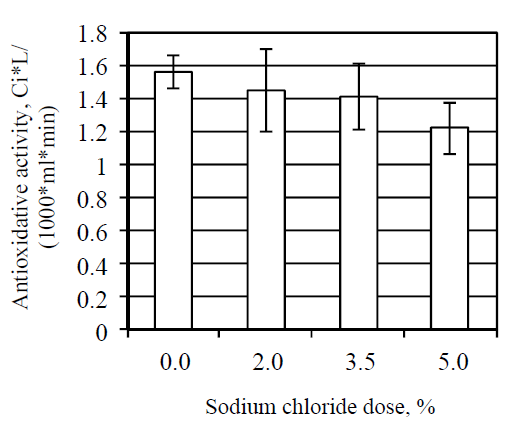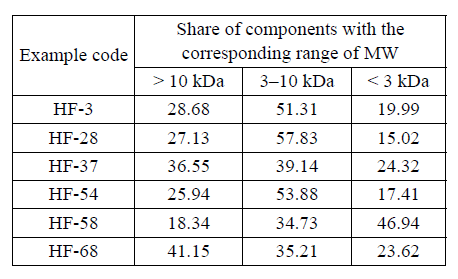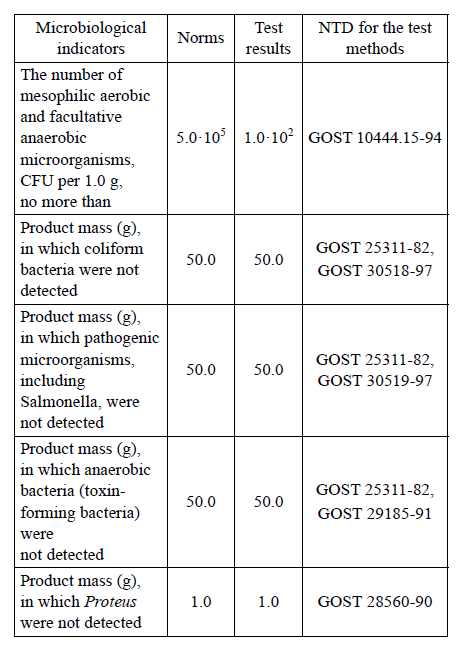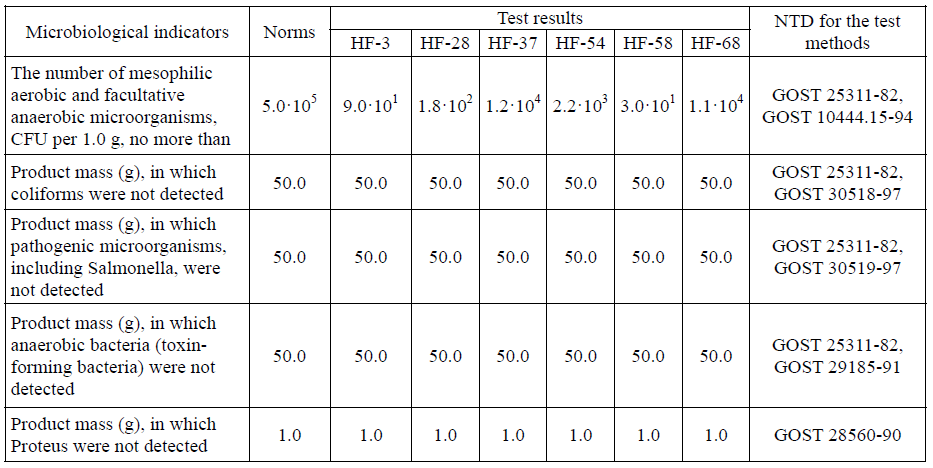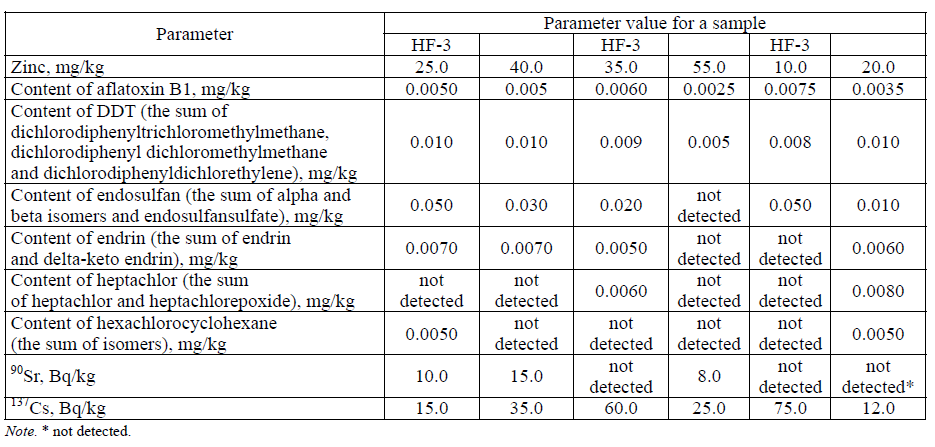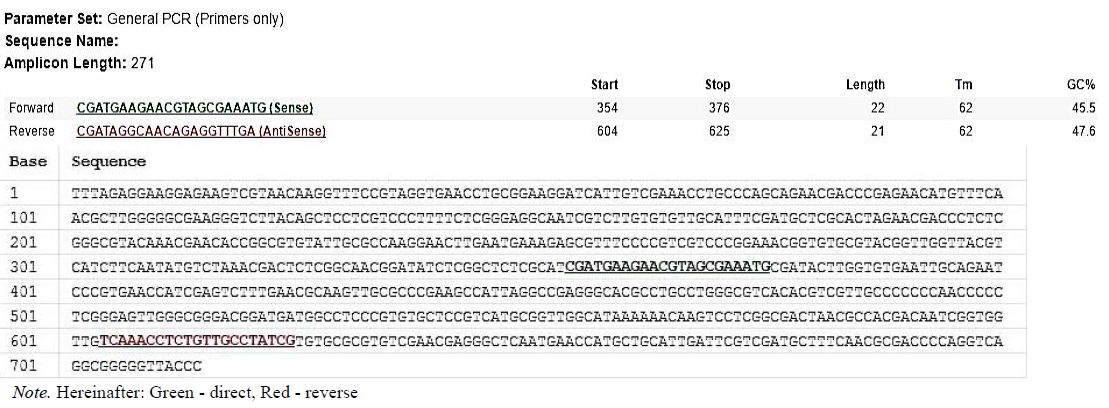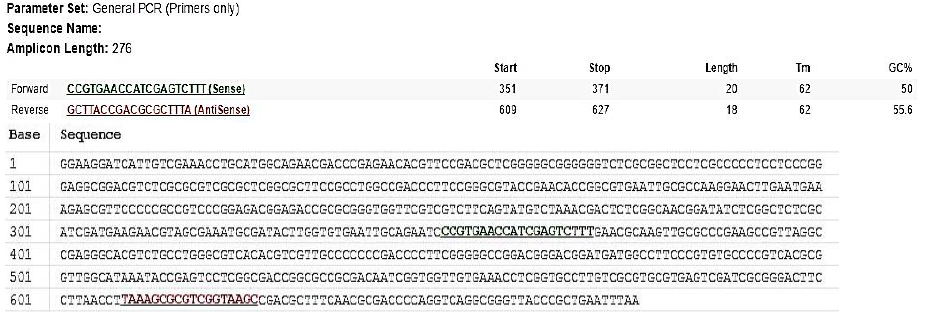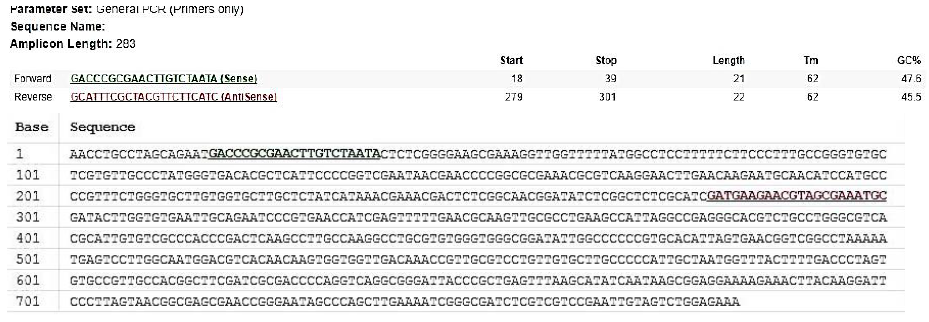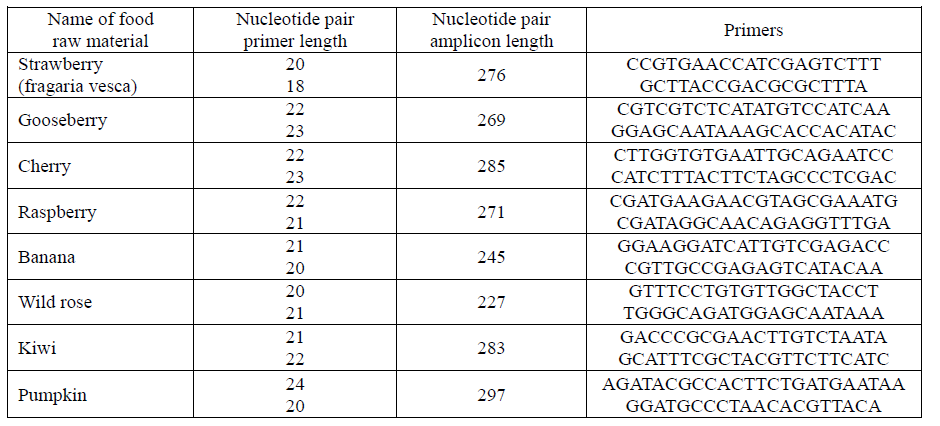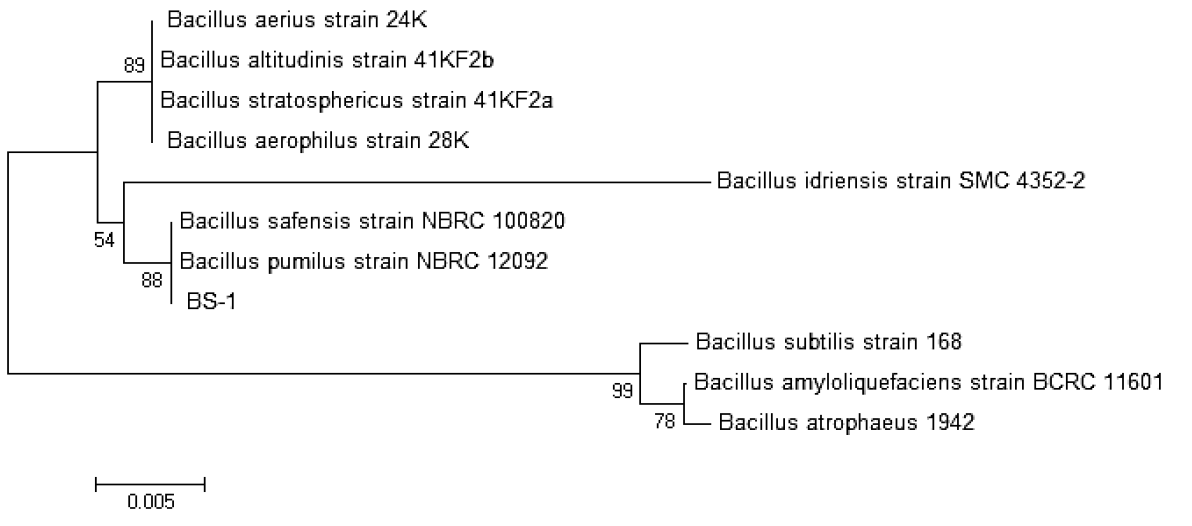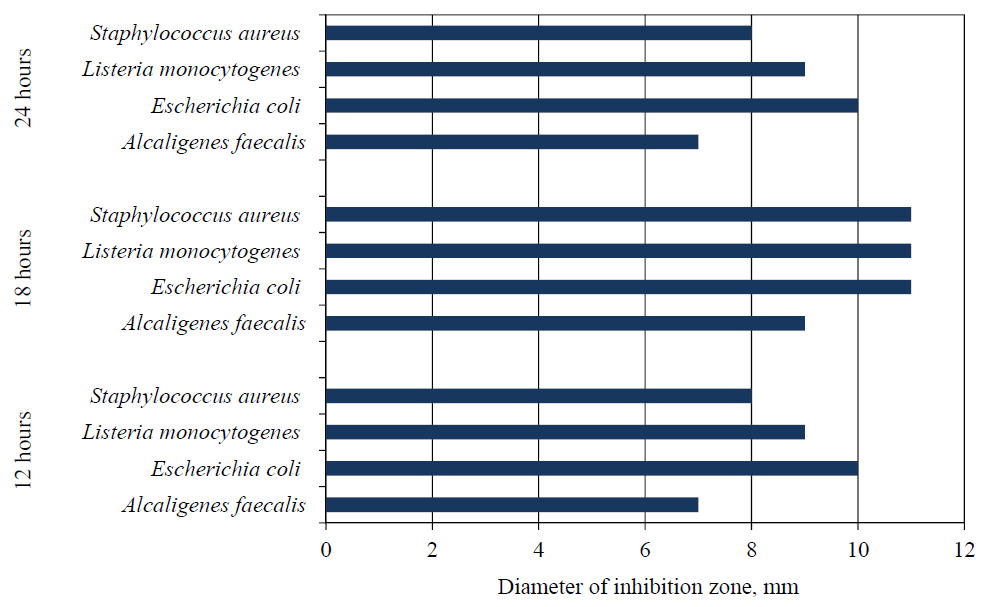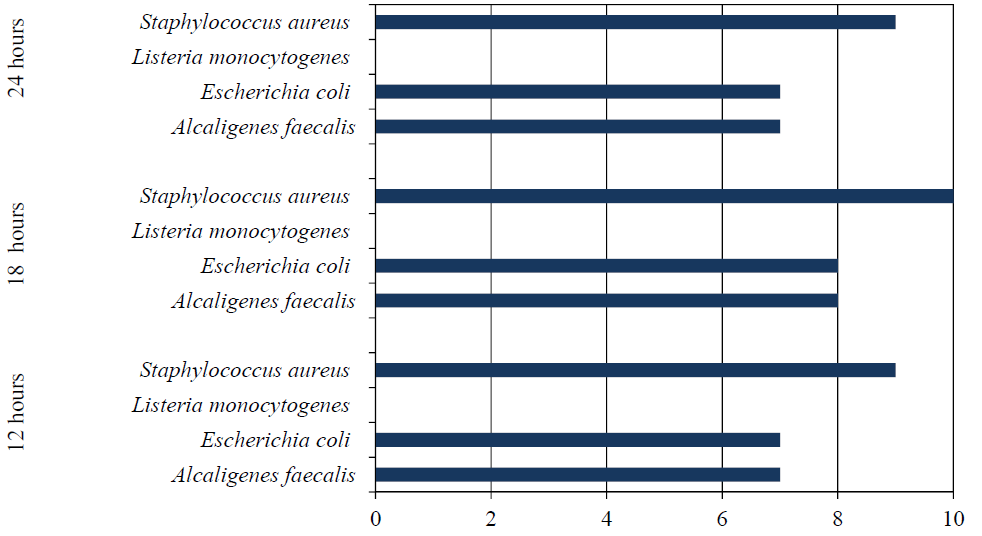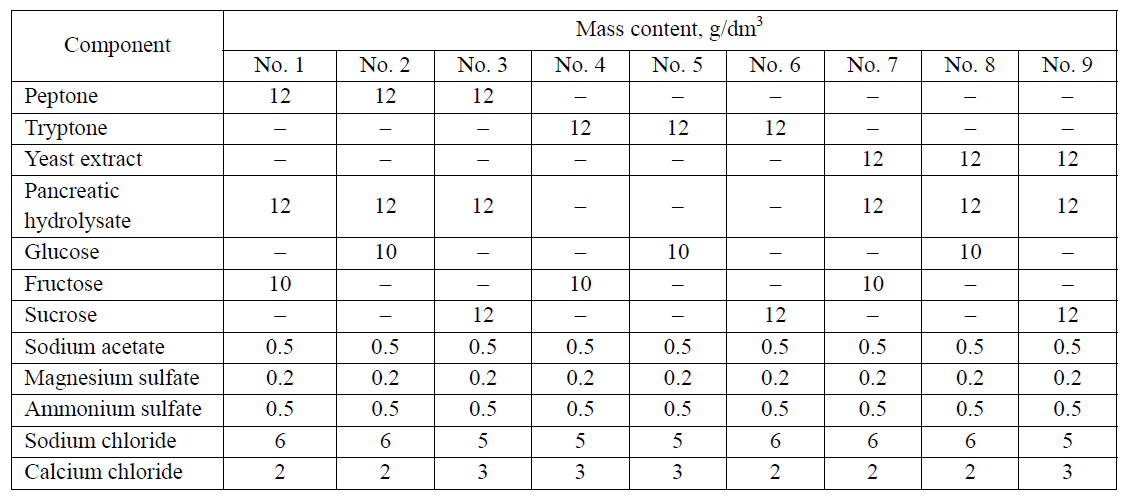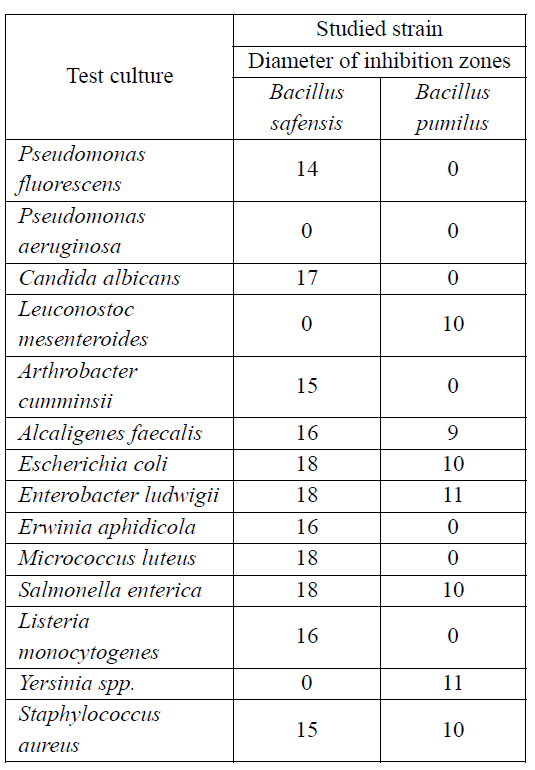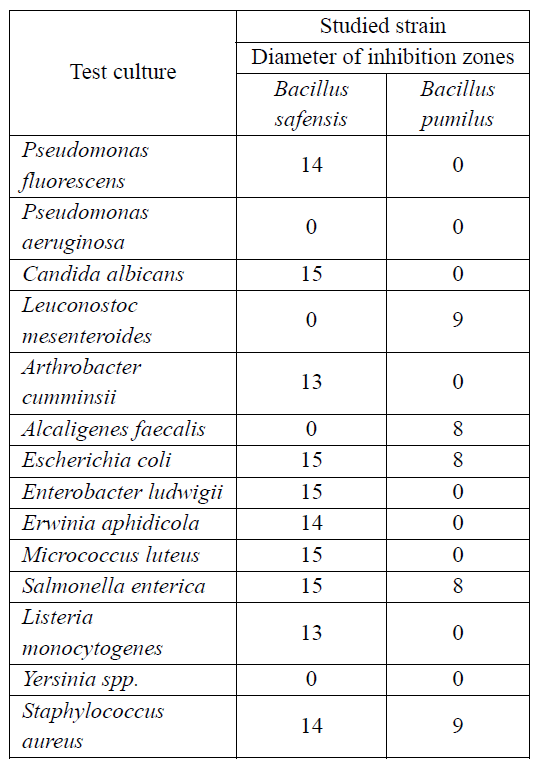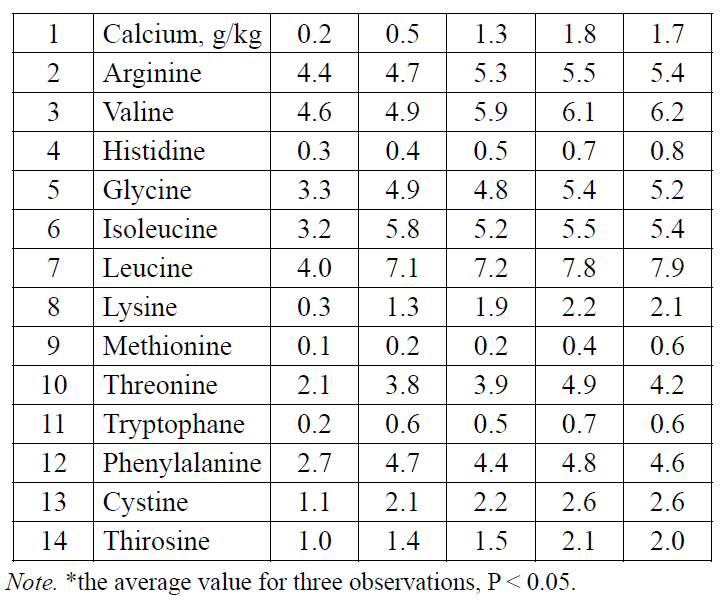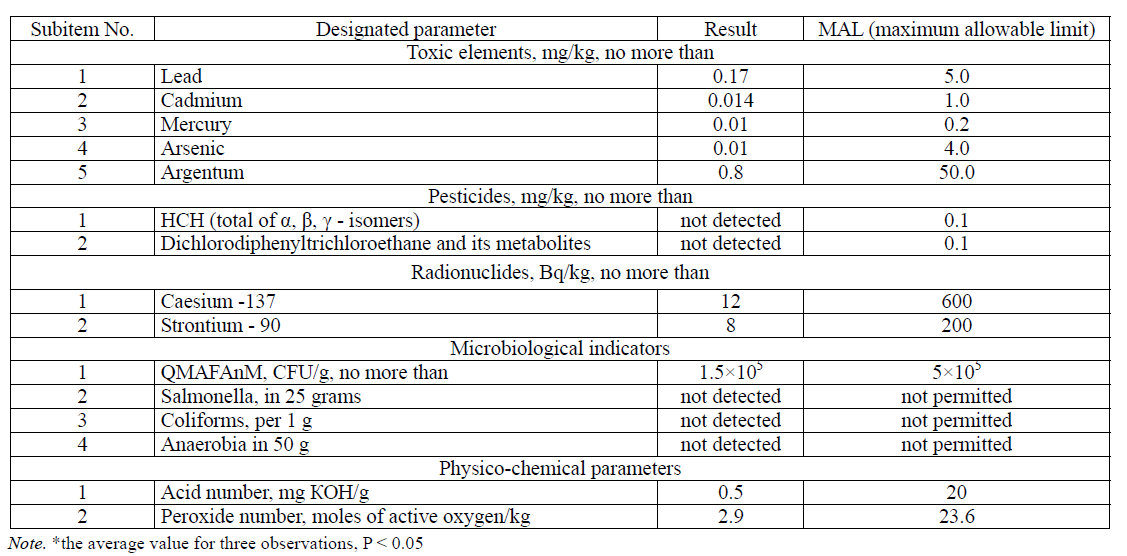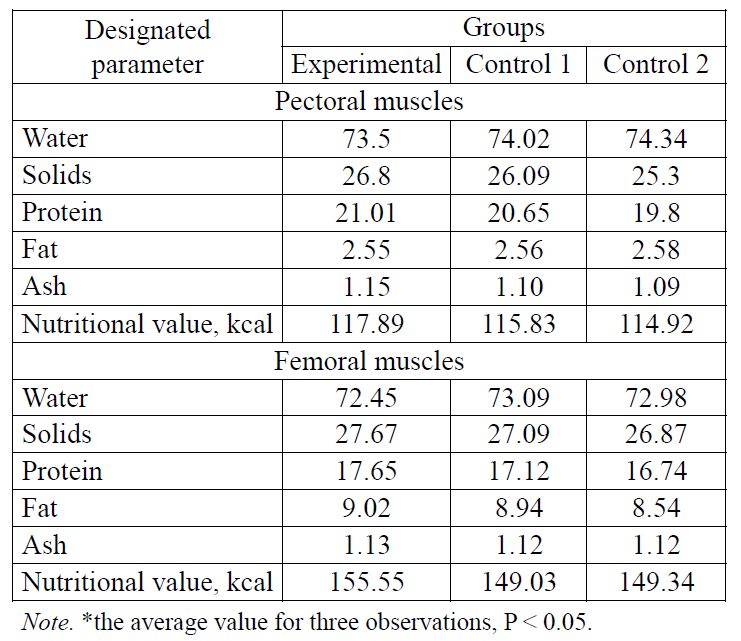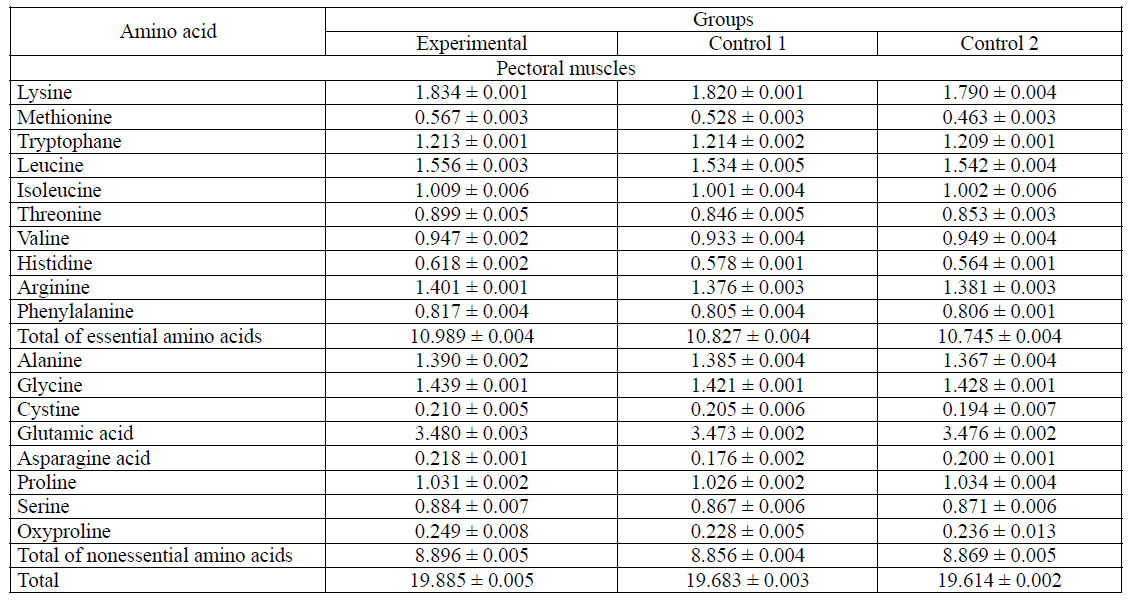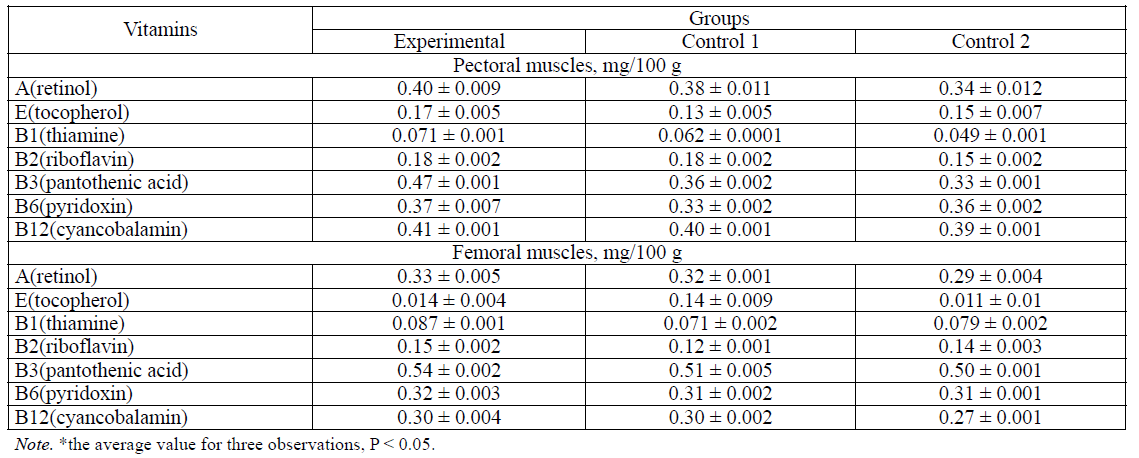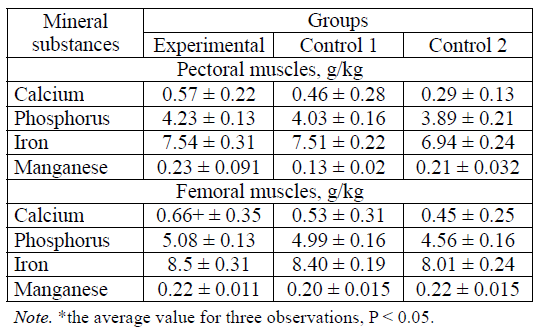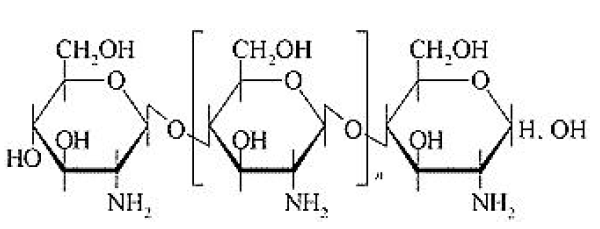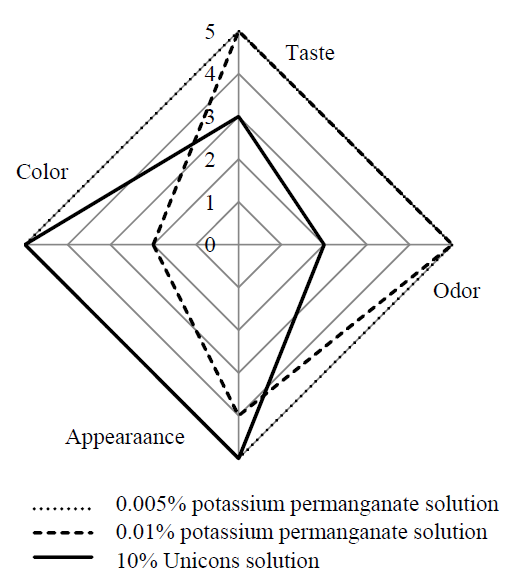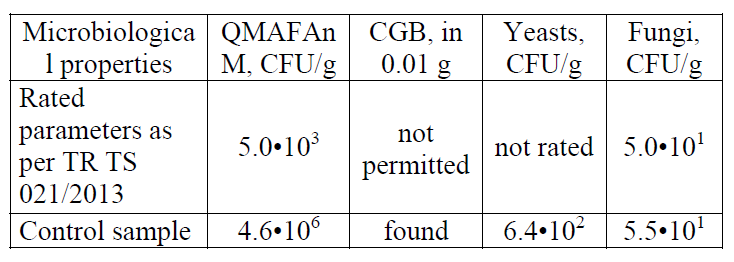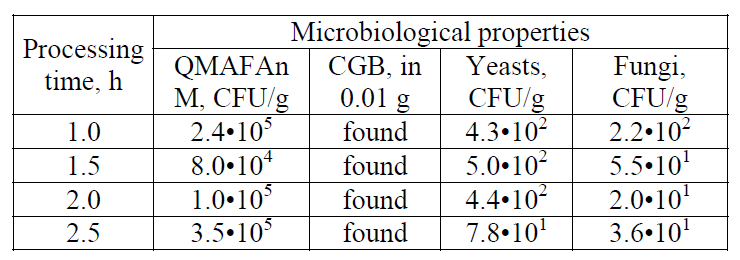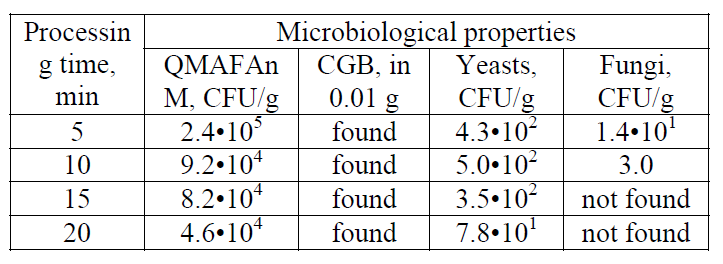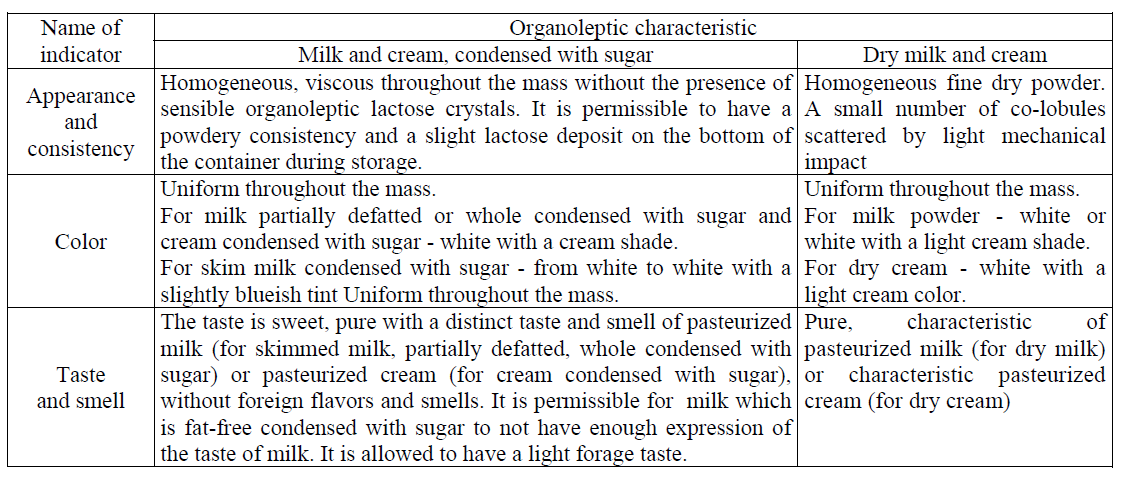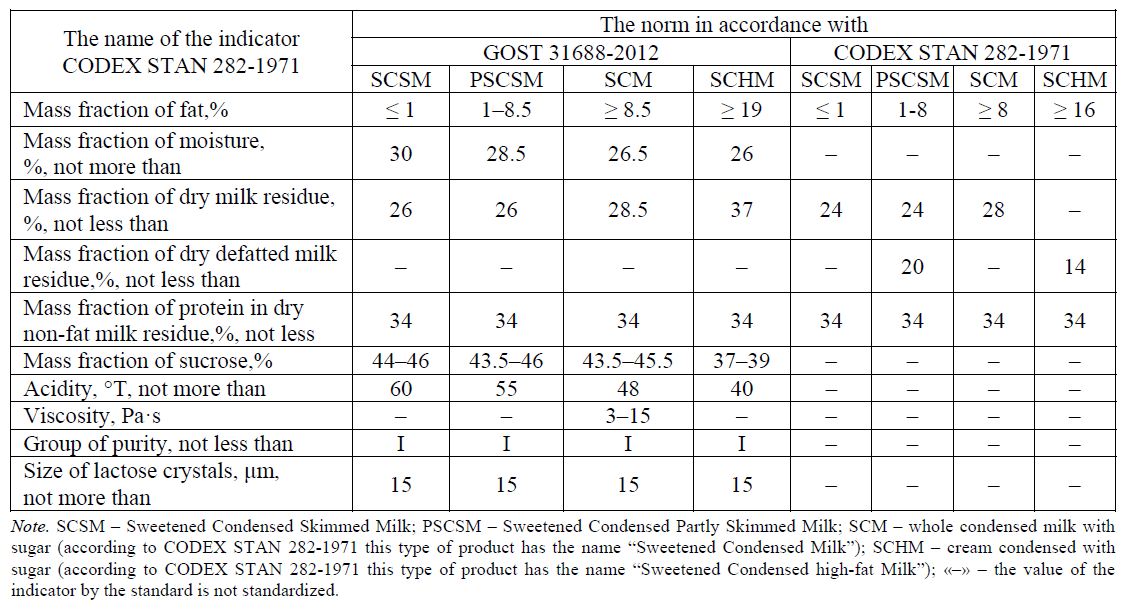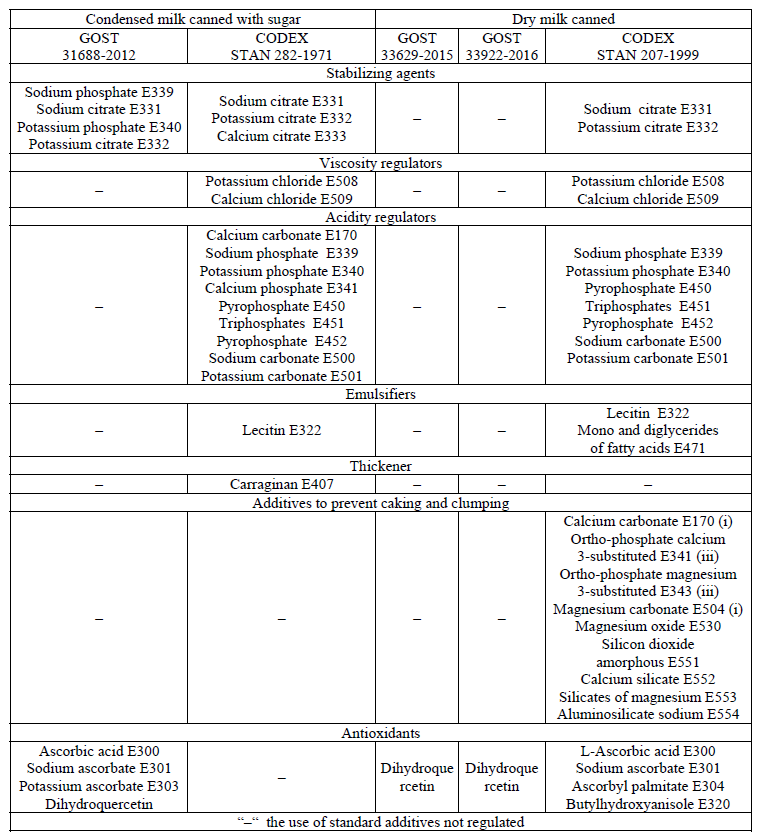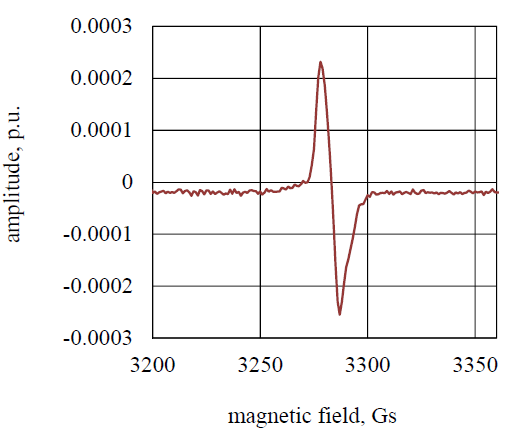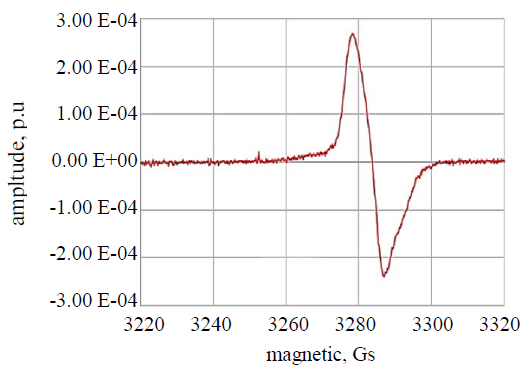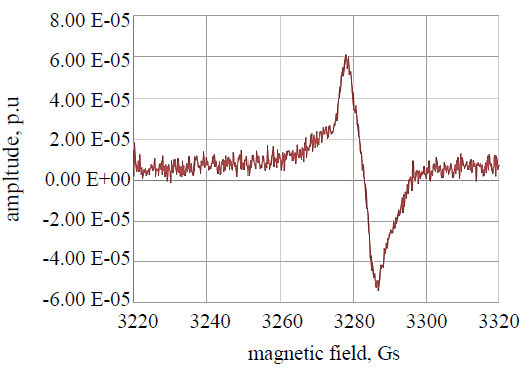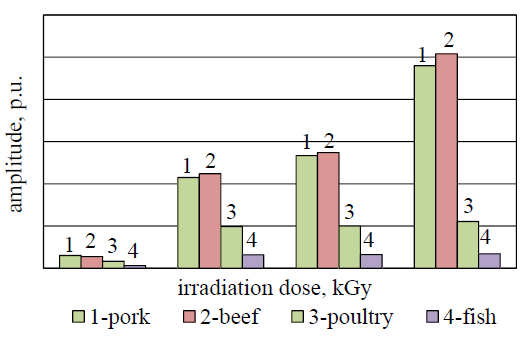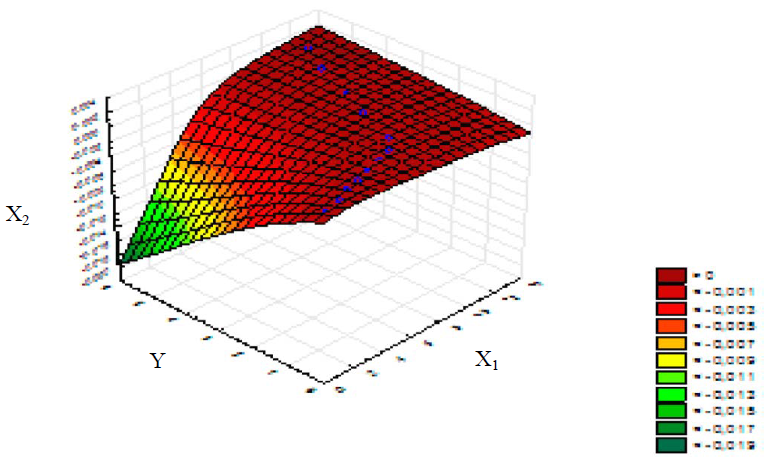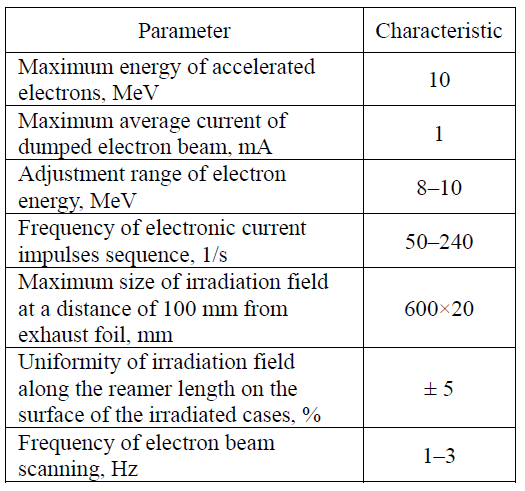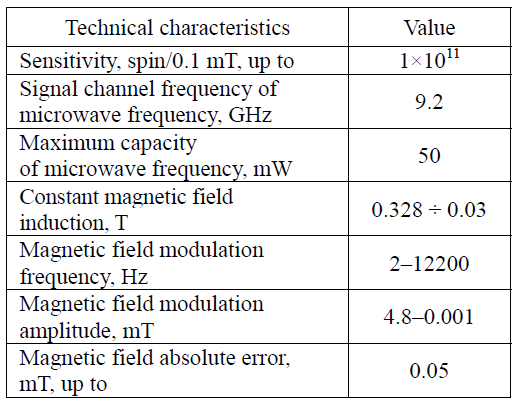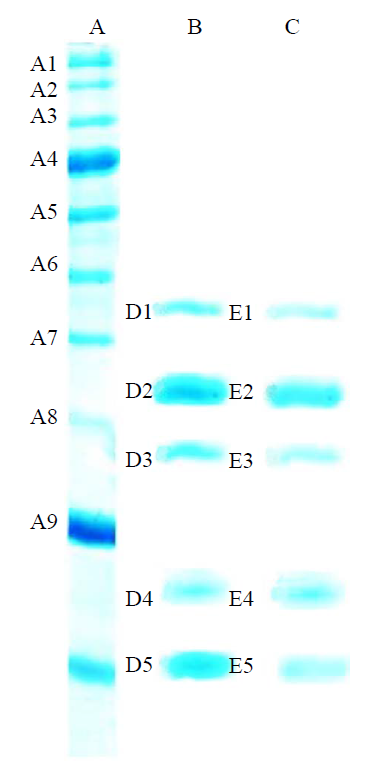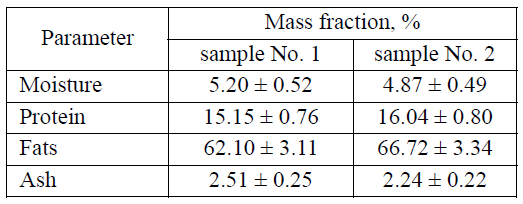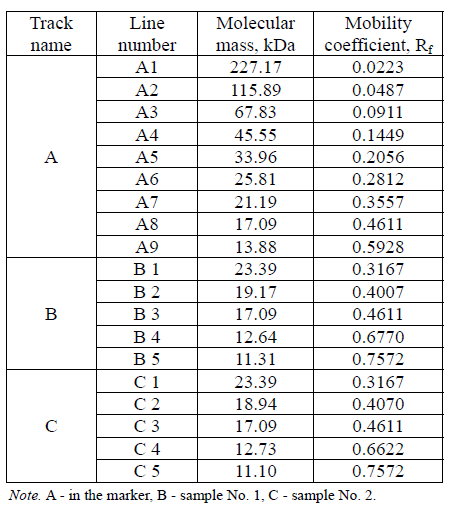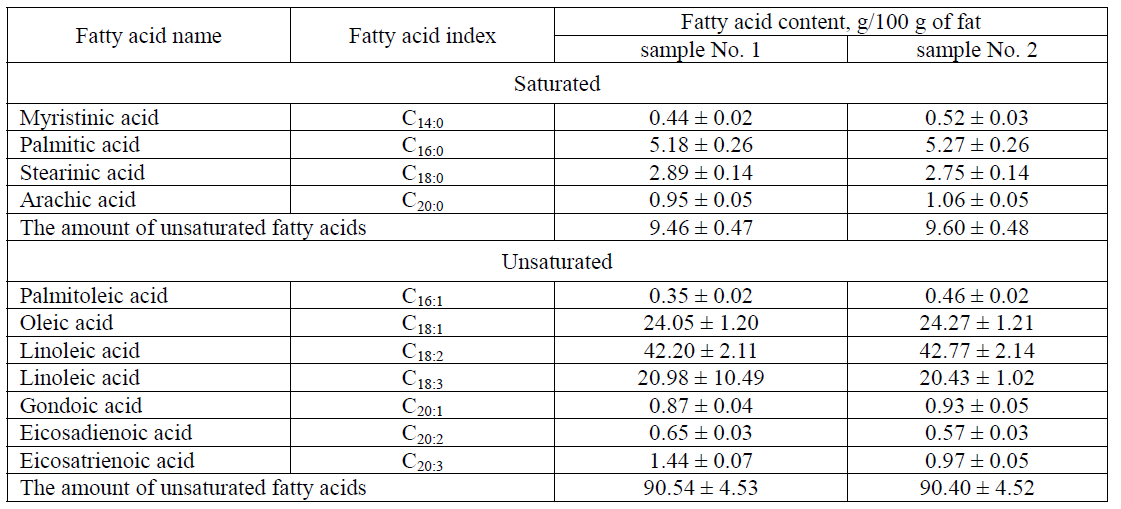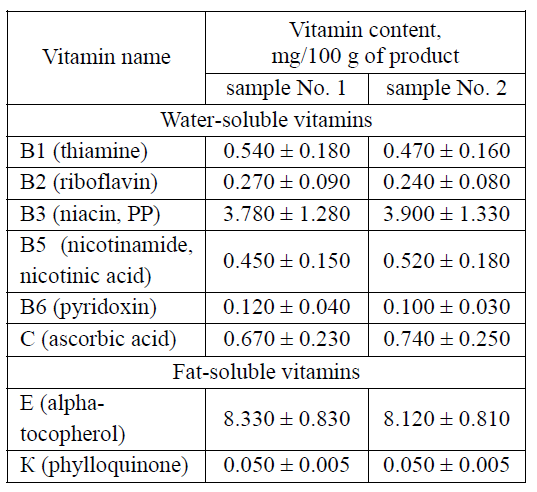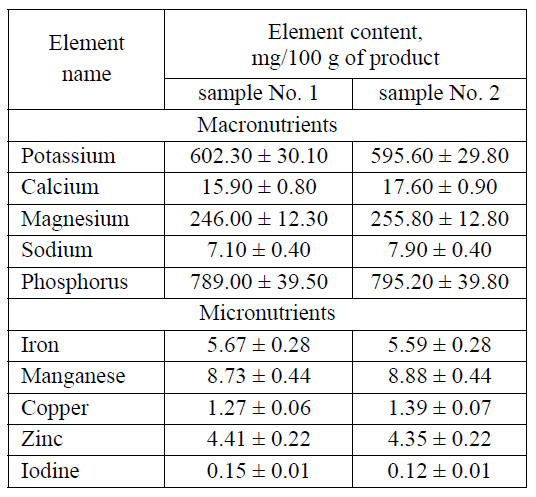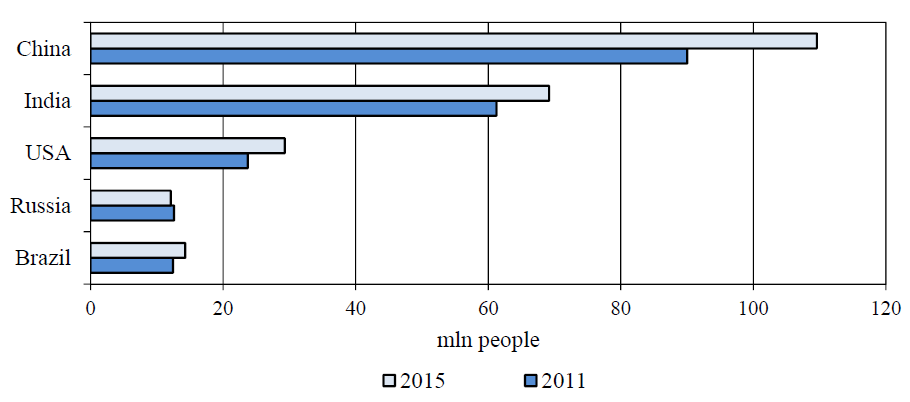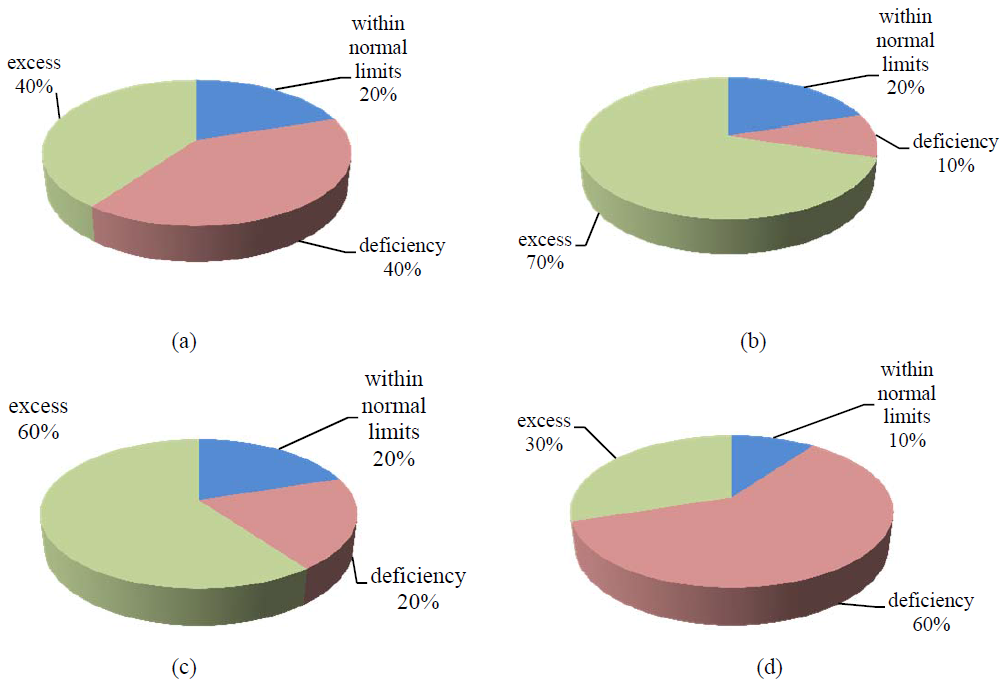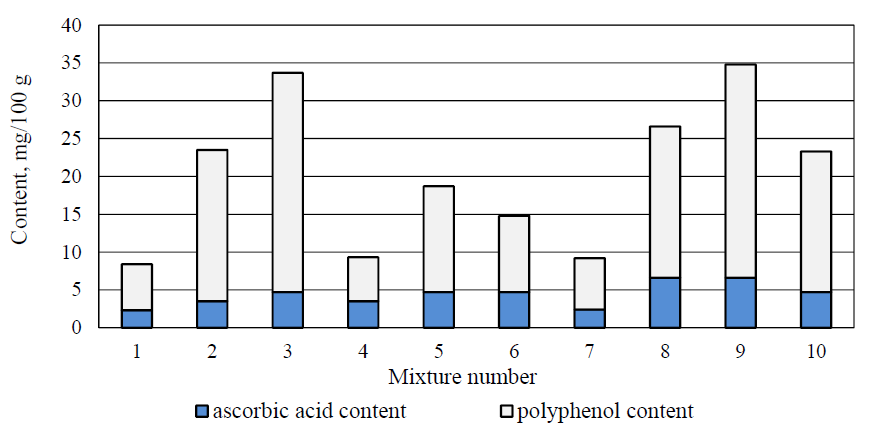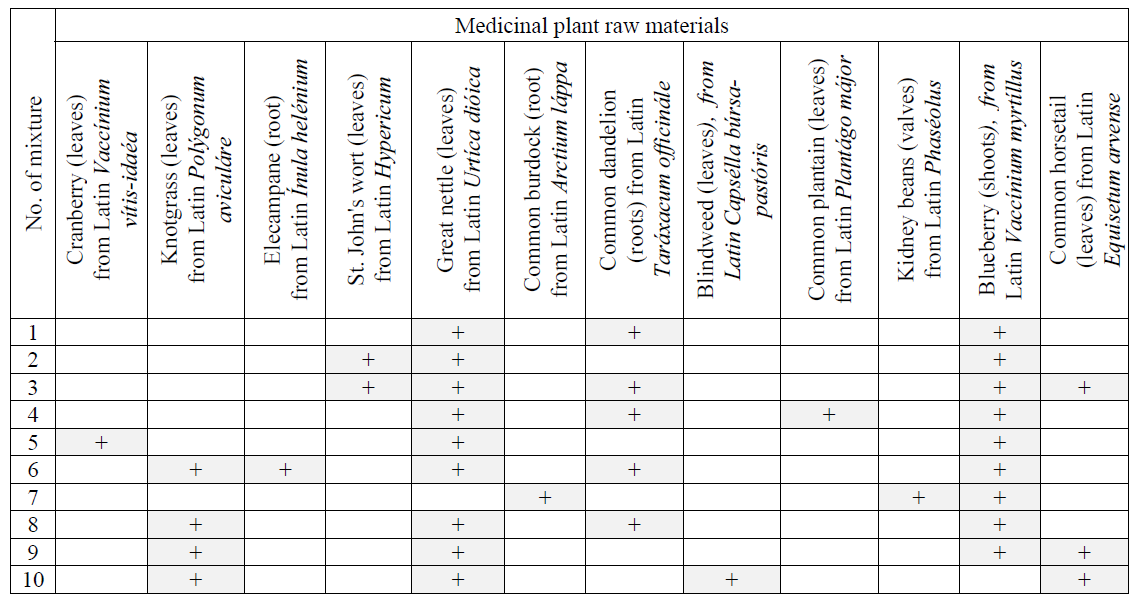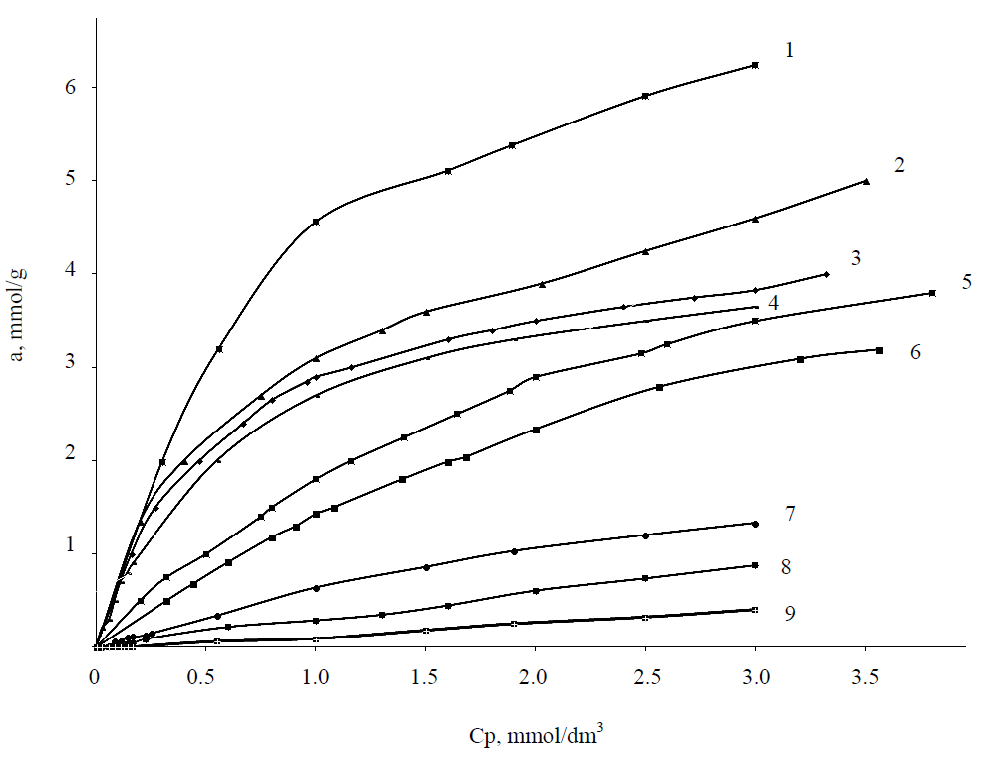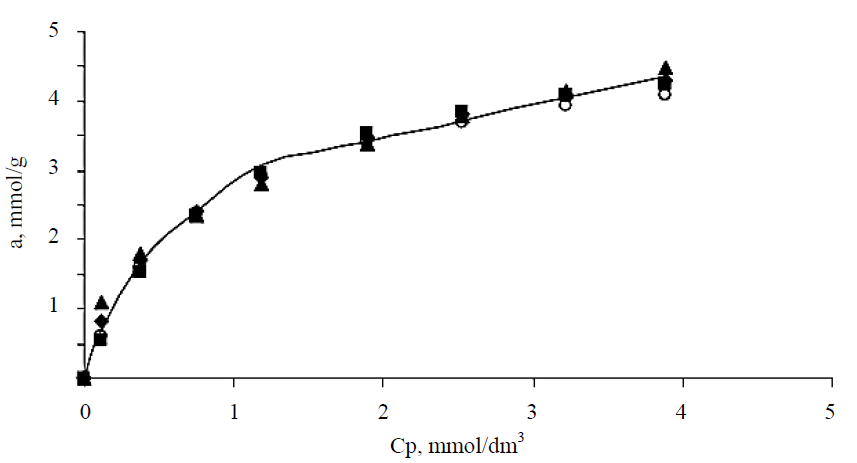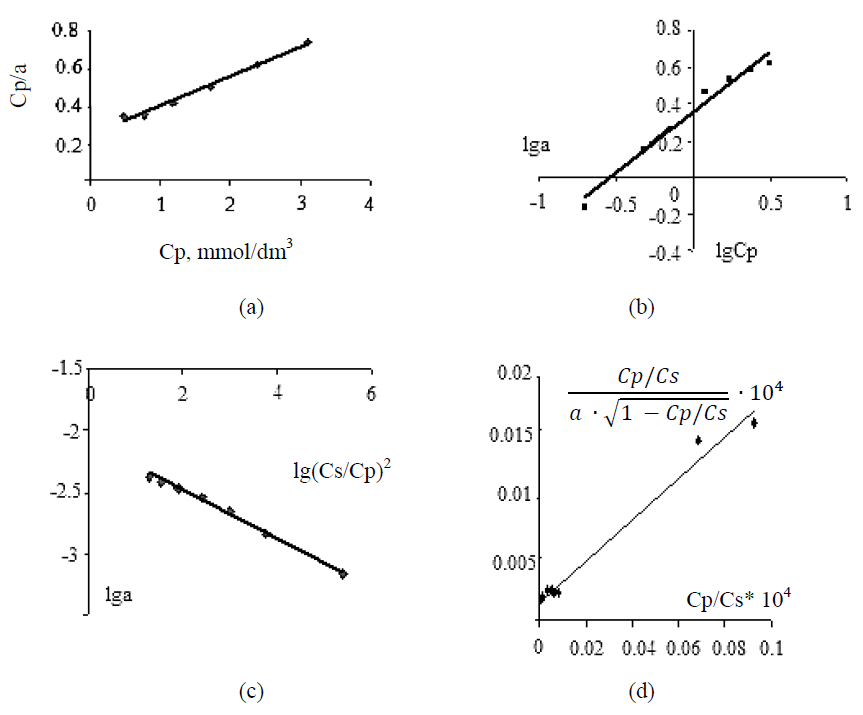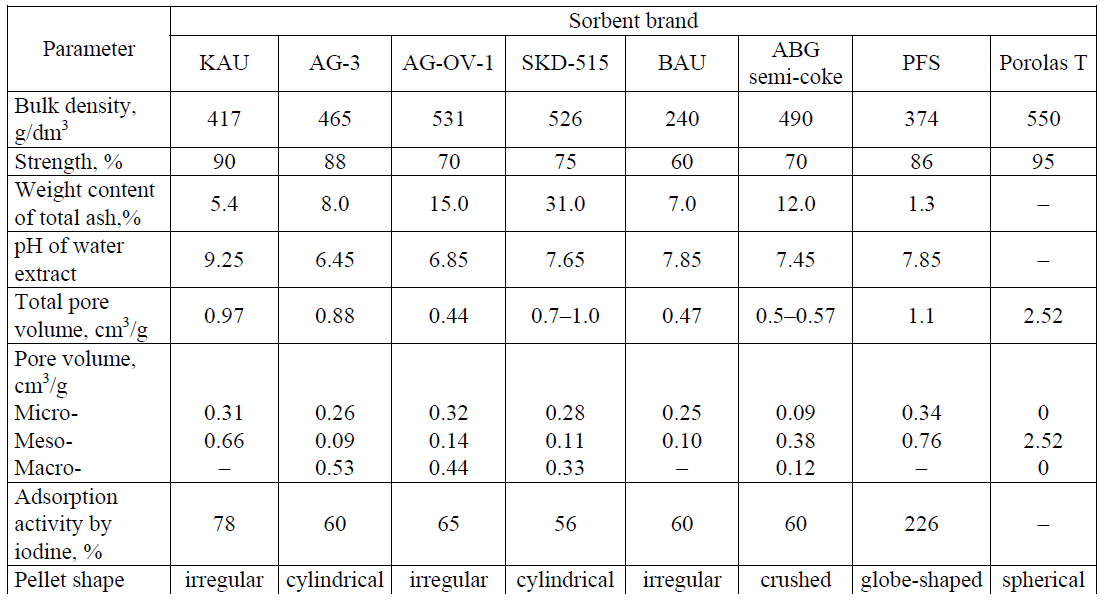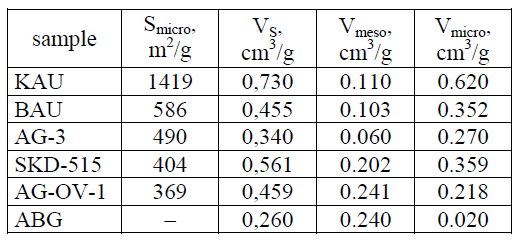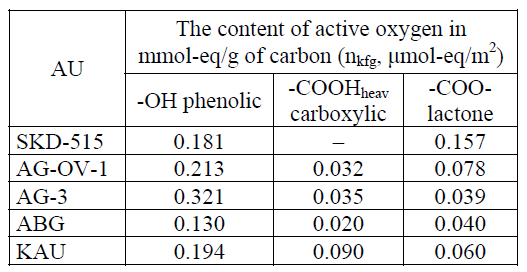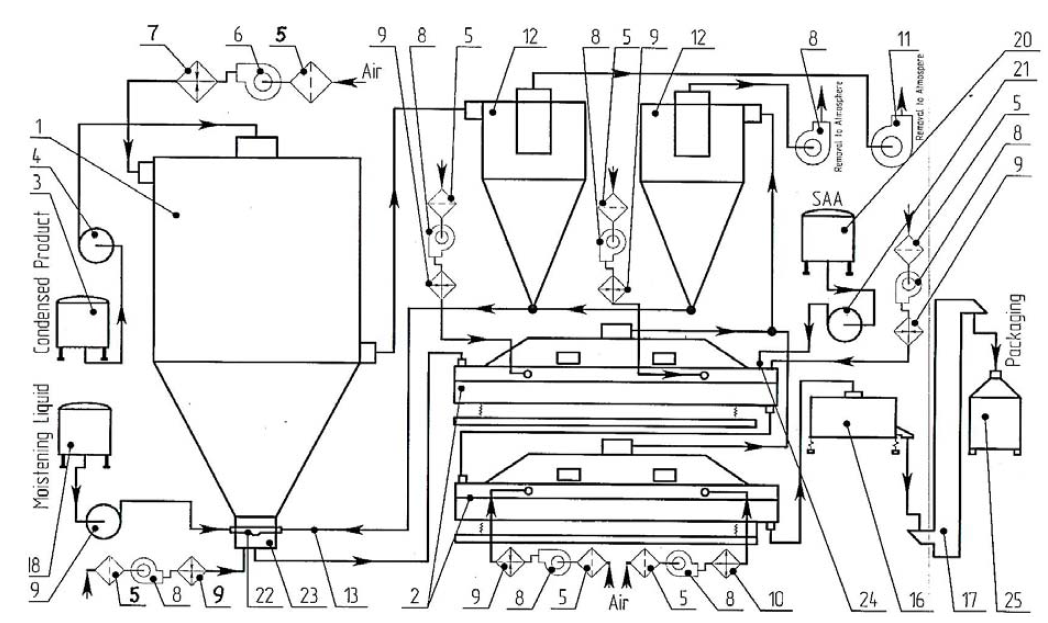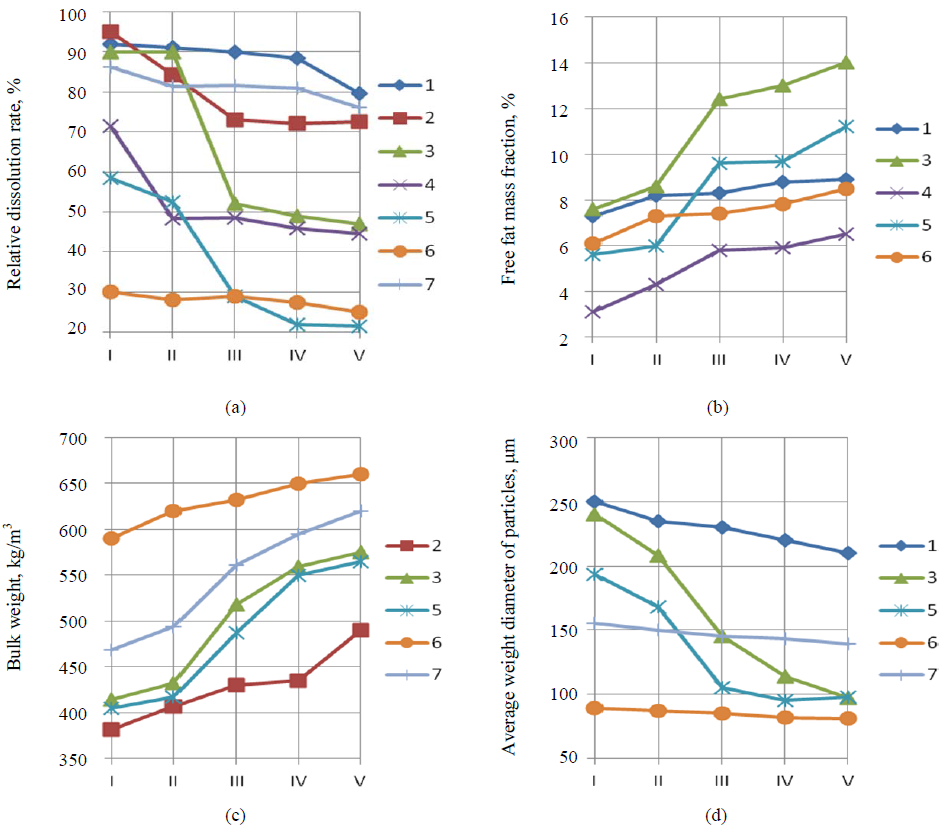Том 5, №2, 2017
9576
Аннотация
Таблицы и рисунки
Biodegradable edible films are developed as alternative packaging materials. Due to their unique chemical composition, apples can act as a raw material for the production of edible films. The aim of the work is to create an edible film from apple raw materials using the following plasticizers: agar, carrageenan or xanthan gum. Edible films have a yellowish color, characteristic for apple sauce. The film with the addition of xanthan gum as a plasticizer has the most acceptable flavor properties. Microscopic examination of edible film samples was carried out using a conventional and laser microscope. The structure of the edible film with an increase in the proportion of fiber becomes more homogeneous. IR spectra with a Fourier resolution of the analyzed edible film samples were obtained, which make it possible to isolate the presence of free hydroxyl groups. For edible films based on apple sauce with the addition of agar and xanthan gum as a plasticizer, there is a tendency to increase the tensile strength with increasing the amount of plasticizer (from 1.32 to 1.70 MPa for agar and from 1.68 to 3.50 MPa for xanthan gum). With a longer time of exposure to water and a higher water temperature, the edible film samples are destroyed
7918
Аннотация
Таблицы и рисунки
The fractional composition of proteins of the cod-fish family - polar cod ( Boreogadus saida ) and blue whiting ( Micromesistius poutassou ) which are currently underutilized in the food industry has been studied. A method of multiple extraction of homogenized fish raw material with solutions of increasing ionic strength and pH was used for protein fractionation. Water-soluble (WSP), salt-soluble (SSP) and alkaline-soluble (ASP) fractions of fish proteins have been separated. The content of protein in a whole fish and its aqueous extracts was determined by the Kjeldahl method as well as photometric method. The amino acid composition of the proteins was studied by high-performance liquid chromatography. Protein of blue whiting comprises 92% of WSP and SSP fractions; while polar cod comprisesonly 60%. All proteins under study contain the full set of the amino acids including essential ones. The content of lysine both in non-fractionated proteins contained in a whole fish and their fractions is considerable (from 59.5 to 121 g kg-1). When evaluating the biological value of proteins, their usefulness is established (there are no limiting amino acids). The data of the rationality coefficient Rc which presents the balance of the amino acid composition of the proteins indicate the high biological value of proteins of the whole polar cod and their ASP fraction. The fish species being studied can be used for production high-grade protein products - fish hydrolysates and isolates. The possibility of using unrefined fish is shown that is peculiarity of novel food technologies for obtaining protein products of high biological value
8696
Аннотация
Таблицы и рисунки
The combination of dairy and vegetable raw materials is considered a technological way of mutual enrichment that allows to optimize the composition and content of fatty and amino acids to a certain extent. The ultrasonic effect contributes to an increase the colloidal stability of products of an emulsion and suspended nature based on vegetable and dairy raw materials. The aim of this work was the study of the process of obtaining protein-containing beverages, vegetable-based in conditions of ultrasonic influence. The main object of the study selected the flour from oilcake of nuts of Pinus sibirica Du Tour (cedar flour). The beverages were obtained using two methods: 1) by scalding cedar flour with the drinking water heated to a temperature of 70°C; 2) by gradual bringing a model mixture of cedar flour with drinking water to the boil. The mass ratios of cedar flour and drinking water were used in the study at 10 : 90 (10% of cedar flour), 10 : 80 (11.1%), 10 : 70 (12.5%), 10 : 60 (14.3%), 10 : 50 (16.7%) and 10 : 40 (20.0%). The model drinks were processed in a cavitation mode (20 W/cm2) of the "Volna" apparatus at the frequency of ultrasonic vibrations of 22 ± 1.65 kHz; the processing time was 2 and 5 minutes. The effectiveness of ultrasound exposure was estimated by the content of dry matters, protein and fat, of size of fat droplets and the colloidal stability of the resulting emulsion. The application of an ultrasonic field provides an increase in the degree of transition of soluble dry matters of cedar flour to the water phase up to two times, including fat ten times and soluble proteins up to two times. As a result, the drops of cedar oil, extracted from the cedar flour are dispersed effectively, resulting in enhanced stability obtained emulsions. The dosage cedar flour within of 14-16.7% under scalding conditions followed by an ultrasound cavitation for 2 min, can be considered as optimal conditions for producing beverages. The analysis of the resulting beverage (2.6-3.4% of protein and 2.8-3.3% of fat) shows its comparability with cow milk
6919
Аннотация
Таблицы и рисунки
Milk and dairy products have a rich nutritional value and they are the main constituents of a human diet. In recent years, the consumption of dairy drinks containing water, sugar syrups and flavorings has been common. So it is important to find a natural alternative sweetener to remove sugar. Therefore, the purpose of this study is to produce flavored drinking yogurt with natural sweeteners like date syrup and fig syrup as a sugar substitute. The study was made of the comparing physicochemical properties and also of opinions about the general acceptance of flavored drinking yogurt with date and fig syrups. The physicochemical properties such as pH, titratable acidity, viscosity, total solid, syneresis and the sensory evaluation of samples were determined weekly at 4°C for 28 days. The results showed that the samples that contained fig syrup had a lower acidity and syneresis percentage while their viscosity was higher compared to the samples that contained date syrup. It can be concluded that flavored drinking yogurt with 10% fig syrup and 1% pectin was chosen as the best treatment since it was rated the highest in general acceptance compared to other samples
6632
Аннотация
Таблицы и рисунки
The development and production of new functional products is a priority for the development of the food industry. At the same time, the quality and biological value of raw materials are of particular importance. From this point of view, when processing milk, the use of the process of membraneless osmosis using polysaccharides is promising. It allows to obtain dairy fractions of a high nutrition value that can be used as the main raw materials in the technology of functional products. The paper aims at developing a functional dessert based on a protein and lipid fraction (PLF) obtained by the fractionation of whole (or normalized) milk using the apple pectin manufactured in Russia. Technological parameters of milk fractionation by pectin have been studied and the conditions under which the process is most efficient have been determined. The most significant parameters were the milk pasteurization temperature (not lower than 85°С) and the concentration of pectin in the system (0.6-0.65 kg per 100 kg of milk). The recommended fractionation method is "cold" at a temperature of 4-6°C. Based on the technological parameters of fractions, depending on the conditions of the process, a method has been proposed for calculating the necessary content of the mass fraction of fat in raw materials to be regulated in PLF. As a practical implementation of the process of fractionation of normalized milk raw materials, a formulation of a new dessert that contains milk fat and protein in the native form has been developed. The functional value of the dairy dessert is provided by a complete replacement of granulated sugar with raw honey, using a starter culture with a probiotic microflora, and concentrating the product with sesame seeds. The study of the biological value of the dessert showed that it fully meets the requirements for healthy food
9139
Аннотация
Таблицы и рисунки
In assessing the nutritional value of a food product, its fatty acid composition is important. Meat products contain essential fatty acids that positively influence human health, and saturated fatty acids, the high level of which does not allow them to be attributed to healthy nutrition. The article describes the use of raw meat from various species of animals and poultry according to their fatty acid composition; presents the possibility of changing the composition of fatty acids to produce healthy food. The presence of trans-isomer fatty acids (TIFA) in food products is the risk factor for human health. Meat raw materials contain trans fatty acids of natural and industrial origin. The results confirming trans fatty acids formation at the stage of animal growth (biohydrogenation and as the result of the use of growth promoters) and during meat processing (heat treatment at high temperatures, storage, use of sodium nitrite) are presented. At present, meat products are not considered to be a source of health-threatening TIFA, but the results presented in the review confirm the need for further research to identify factors that affect the fatty acids isomerization process in meat and semi- meat products and the normalization of their content in finished products
7481
Аннотация
Таблицы и рисунки
A carbohydrate based fat replacer is the most important constituent used in a large range of bakery products. It exactly minimizes the role of butter, margarine and fat. It also plays a major role in the reduction of obesity. Carbohydrate based fat replacers also effect in terms of physical and chemical properties. The present study was designed to reveal the combined potential of pectin and banana powder as carbohydrate based fat replacers in cookies. The flour was characterized for a proximate analysis (moisture, fat, fiber, protein, ash and NFE). Moreover, carbohydrate based fat replacers (pectin and banana powder) were mixed with flour at different levels (0%, 5%, 10%, 15% and 20%). Fat replacers of different flour containing levels were studied for rheological properties (farinographic) and were used in baked products such as cookies for enhancing their quality characteristics. Moreover, physical and chemical analyses were carried out. Furthermore, the sensory evaluation of cookies was also carried out. The obtained data from each parameter were subjected to an appropriate statistical analysis for determining the level of significance. The results showed that the content of crude fat was 29.82% in the controlled cookies. The fat content was reduced from 29.82% to 17.07% for T3 by using carbohydrate based fat replacers. The current study revealed that the treatment with T3 better attributes to physical, chemical and rheological properties. The results further affirmed that the cookies prepared from wheat flour from 15% supplementation of carbohydrate based fat replacers showed better attributes regarding color and texture and were declared the best by the panelists
9004
Аннотация
Таблицы и рисунки
The study has been carried out at the All-Russian Research Institute of Grain and Its Processing Products. This paper describes the formation of new grades of triticale flour based on the cumulative ash curves the analysis of technological and biochemical indicators of which showed that flour of the grades T-60, T-70 and T-80 obtained from endosperm can be used directly in bakery, flour of the grades T-120 and T-220 obtained from peripheral parts and triticale bran can be limitedly used in bakery, and are mainly raw materials for further processing. On the basis of the study of the kinetics and efficiency of the effect of proteolytic and cellulolytic enzyme preparations (EP) and their compositions, optimal conditions for enzymatic modification (the EP dosage is 0.5-0.75 units of PA/g of flour, 0.3...0.4 units of CA/g of bran, the optimum temperature is 40-50C, pH is 5.0 and 3.5, the duration of reactions is 1.5 and 2 hours) have been determined. It has been shown using the gel-chromatography method that the use of multienzyme compositions (MEC) of proteases allowed to hydrolyze triticale flour proteins completely and to use the obtained hydrolyzate as a component of hypoallergenic and gluten-free flour products. The use of cellulolytic EP allowed to increase the amount of reducing substances and soluble protein by 1.5-2.5 times in comparison with the control sample. The biomodified bran obtained using the MEC "Shearzyme 500 L" + "Neutrase 1.5 MG" and "Viscoferm L" + "Distizym Protacid Extra" has a high degree of hydrolysis of non-starch polysaccharides and proteins, is characterized by a certain ratio of high-, medium-, low-molecular peptides and amino acids, has different functional and technological properties. They can be used in the production of a wide range of general-purpose, functional and treatment-and-prophylactic food products
7999
Аннотация
Таблицы и рисунки
One of promising methods for caseic whey processing is the production of whey protein microparticulate and its consequent application in food technology. This work is aimed at the development of fermented milk product technology using the whey protein microparticulate based on caseic whey. The researches were carried out at the Chair of Animal Product Technology of the Voronezh State University of Engineering Technology, at laboratories of Kombikorm Scientific and Production Complex, Mollab LLC (Voronezh), at the laboratory and pilot shop of the Voronezh Dairy Plant JSC. Standard and generally accepted physical, physico-chemical, chemical, microbiological, physiological and technological research methods were applied by investigators in the course of the study. The sequence of technological operations to obtain the microparticulate covered pre-preparation of curd whey, ultrafiltration, heating to denaturation temperature and dispersion. This is to ensure protein particle formation average sized 3 μm and formation of unique properties of the microparticulate. Valuable properties of the caseic whey microparticulates are applied in the technology of milk product fermentation. The chosen ferment allows preservation of the required fermentation time (5-6 hours) and to obtain the viscous, creamy consistency of the product. The microparticulate is efficiently proportioned, that is, 10%. We studied the option to use the caseic whey microparticulate in the technology of kefir production. It is found that microparticulate facilitated intensification of process fermentation (10 h long) and maturation (6 h), enhancement of kefiran synthesis by kefir fungi microorganisms, intense formation of carbon dioxide and other osmophoric compounds. Formulations of kefir and sour milk drink are suggested that allow using 10% of microparticulate. Production schemes have been developed and customized to the HACCP system that consider introduction of supplementary operations to obtain the caseic whey microparticulate. The technological solutions developed are known for the following key advantages: realization of the complete production cycle; increase in food biological value; reduction of technological process length due to souring stimulation
6420
Аннотация
Таблицы и рисунки
Along with necessary substances for yeast, wort also contains extraneous impurities and technologically important components that affect the cells adversely. The effect of these compounds on yeast can be mitigated by adding adsorbents and stabilizers into a fermentation medium. In this article, methods of improving brewer’s yeast viability by removing phenols and high-molecular-weight proteins from wort are considered to accelerate the fermentation process and improve the final product quality. Both traditional materials (natural zeolite-containing tuffs from different fields of Siberia) and new ones (carbon-containing fibers and cyclodextrins) were suggested to transform wort composition. It has been revealed that introduction of 5% of zeolites into a mash at 70°C, or filtration of hopped wort through a mineral or carbon fiber layer at 0.10 l/min reduces haze-forming components content by 12-25%. Without significant effect on other characteristics of wort, polyphenols tend to be absorbed more than proteins. Addition of cyclodextrins in amount of 0.1-5.0% (w/v) into wort before fermentation contributes to clathrate formation with proteins and phenolic compounds. The materials used provide favorable conditions for yeast: biomass increases by an average 20%, yeast growth and extract fermentation intensify, and by-products formation decreases. This allowed us to shorten the fermentation process by 1-1.5 days, produce beer with desired organoleptic parameters, and increase its resistance to colloidal hazes formation
8156
Аннотация
Таблицы и рисунки
Meat technological processing has a significant effect on the dynamics and depth of the oxidative processes. The study on the antioxidative activity of the extracts, obtained from the salted meat samples before and after the thermal treatment, was carried out in order to establish a mechanism of action of the main technological processes (meat salting and thermal treatment) on the oxidative changes. The subjects of the research were the samples of pork Longissimus dorsi muscles, which were minced and salted with sodium chloride in the amount of 0.0, 2.0, 3.5 and 5.0%. The antioxidative activity was determined by the rate of oxidation of reduced by oxygen form of 2.6-Dichlorophenolindophenol. The catalase activity was measured spectrophotometrically by the rate of hydrogen peroxide decomposition; the superoxide dismutase activity was measured by the rate of inhibition of the pyrogallol autoxidation; the glutathione peroxidase activity was measured by the rate of NADPH decomposition. The research was carried out at V.M. Gorbatov Federal Research Center for Food Systems of RAS (Russia). According to the study results, meat salting initiated a decrease in the meat antioxidative activity by 9.2-18.0% depending on the sodium chloride concentration. Meat salting with sodium chloride in the amount of 5.0% led to a decrease in the activity of glutathione peroxidase by 24.6%, catalase by 60.1% and superoxide dismutase by 33.7%. The correlation dependence between the antioxidative activity and catalase activities, as well as between superoxide dismutase and glutathione peroxidase activity was revealed: the absolute values of the correlation coefficients were 0.97, 0.99 and 0.94 respectively. In the conducted research a decrease in the meat antioxidative activity by 22.9-28.3% (р < 0.05) was recorded under the action of high temperatures (72 ± 2°С) as a result of catalase inactivation and catalase partial inactivation of superoxide dismutase and glutathione peroxidase. The thermal treatment neutralized the sodium chloride negative effect on the antioxidative activity and activity of the meat antioxidative enzymes (р > 0.05). The obtained results on a decrease in the antioxidative activity in the meat salting process justify the necessity to develop approaches that allow reducing the sodium chloride content in meat products in order to retard the oxidative changes without deterioration of product consumer characteristics
7679
Аннотация
Таблицы и рисунки
Feeds, feed preparations and high-protein feed supplements are complex multicomponent compositions that, when stored, used, processed and transported, can change their physicochemical properties, microbiological indicators and toxicological properties. In this regard, it is very important to study the above properties and quality indicators. The paper describes a study of the peptide profile, physico-chemical and toxicological properties of the enzymatic hydrolysates of feather-down raw materials obtained during a multifactorial experiment to optimize the conditions for enzymatic hydrolysis of feather-down raw materials. The raw materials were previously subjected to a short-term hydrothermal treatment to improve the course of enzymatic hydrolysis. The enzymes obtained from bacterial organisms were used for the enzymatic hydrolysis of raw materials: Protolade B and Protease 2630#2256. The following results were obtained for the physicochemical properties of enzymatic hydrolysates: the content of protein and solids in the enzymatic hydrolysates of feather-down raw materials varied in the range of 1.80-3.00% and 2.6-4.4%, respectively. In this case, the mass fraction of protein was 67.7-70.6% in terms of the mass fraction of moisture. The mass fraction of ash, in terms of the mass fraction of moisture, did not exceed 0.43% in all the samples of enzymatic hydrolysates, the mass fraction of fat was 0.74%, the mass fraction of crude fiber was 1.28%, the mass fraction of sodium chloride was 1.92% the mass fraction of the impurities insoluble in hydrochloric acid was 0.77%. It has been shown that enzymatic hydrolysates corresponded to TU 9219-094-23476484-09 “Hydrolyzed feed flour. Feather protein concentrate” for their microbiological properties (QMAFAnM, coliforms, pathogenic microorganisms, toxin-forming anaerobic bacteria and bacteria of the genus Proteus) and chemical safety parameters
7079
Аннотация
Таблицы и рисунки
Identification has similarities and differences with other kinds of assessment activity: quality assessment, control management and certification. The final result of identification is verification of compliance or detection of falsification. Common features are tests for definition of actual values. This paper studies the design of universal primers for type identification of fruit raw material (strawberry, gooseberry, cherry, raspberry, banana, wild rose, kiwi). To further verify the specificity of primers, sequencing of fragments is produced, which are read by each from the primer pairs. For this purpose, 8 polymerase chain reactions (PCR-reactions) are initiated, one from each primer pair corresponding to one type of raw material. A single alignment matrix for each of the studied objects is created as a result. Re-verification of each matrix is conducted for the presence of read errors or other disputed single- nucleotide substitutions. It is stated that the alignment matrices of the nucleotide sequences of raspberry, strawberry (fragaria viridis), gooseberry, wild rose, cherry, banana and kiwi are aligned on all sides and the protruding "bases" do not disturb the future work of programmes for the primers design. Universal non-intersecting primers are chosen to identify the fruit raw material under studying. As a result of the use of various software packages and of the database GenBank NCBI, we managed to find a suitable DNA zone for each of the tested samples of fruit raw material at the level of generic differentiation for further development on its basis of the universal primers. It is zone 18S rDNA. All the found sequences have both the conservative part for planting a pair of primers, and the variable one for reliable identification of species or for phylogenetic analysis. As part of the study, all samples of fruit raw material have been identified
16506
Аннотация
Таблицы и рисунки
Bacteriocines are substances of protein nature, which are produced by many strains of microorgamisms. Due to the fact that bacteriocins are effectively used as antimicrobial agents in medicine and food industry, isolation and study of the properties of new bacteriocins-producing strains is very important. It should be noted that production of bacteriocins by microbial cells directly depends on strain cultivation conditions and methods of bacteriocin isolation. Among other cultivation parameters such as temperature and the active acidity of the culture medium, the duration of cultivation directly influences the synthesis of bacteriocins. Thus, the selection of the optimum duration of strains cultivation and method of bacteriocin isolation would allow us to increase significantly the bacteriocin production and, hence the antimicrobial activity of the strains. Therefore, determination of the optimum duration of cultivation and method of bacteriocins isolation is a very important step for getting bacteriocins with maximum activity. In this study, the isolation of microbial cultures from the fresh onion surface and the identification of these strains by sequencing of the 16S RNA gene were carried out. Also their morphological and physiological-and-biochemical properties were studied. The optimum cultivation duration was performed by using the determination of the antimicrobial activity in different time intervals. The strain cultivation was carried out during 24 hours. Three methods were used to isolate bacteriocins. They were based on the using of activated carbon, ammonium sulfate, and chloroform. The antimicrobial activity of bacteriocins was studied by means of the disk diffusion method. The identification of the isolated strains has revealed that the strains belong to Bacillus safensis and Bacillus pumilus species. It was found that the bacteriocins had the greatest antimicrobial activity when being cultivated for 18 hours and using method based on ammonium sulfate precipitation.
17891
Аннотация
Таблицы и рисунки
Poultry farming is one of the largest branches of agriculture with a high level of production of a variety of organic wastes that require special approaches to useful utilization. The article describes the problem of processing evisceration waste and keeping poultry in quality feed supplements and the estimation of their effectiveness in feeding broiler chickens. In accordance with the studies, it has been established that the studied feed supplements, with a share of feather-down waste of more than 80%, differ in a balanced amino acid composition, a high content of protein (89.9-90.2%) and sulfur-containing amino acids, that is cystine and tryptophan that have a high value in the process of fattening the bird. The ratio of 8 : 2 (feather-down waste : litter) is recognized rational and optimal for a further use - the feed supplement produced using this method contains glycine, the most important amino acid for chickens, and is characterized by a high content of calcium and phosphorus due to the components of litter. According to the safety indicators established by the regulatory documents, the feed supplement is recognized high-quality and safe. When estimating the toxicity of the feed supplement using the test organism Tetrahymena pyriformis , no adverse effect on the survival, mobility, growth and behavior of the cells was detected. When analyzing the relative biological value of the feed supplement using Tetrahymena pyriformis , it has been established that the average number of the cells grown withthe use of the feed supplement is (8.9 ± 0.9) × 104 cells, which indicates its high nutritional value. Taking into account the results of the studies on the chemical and amino acid composition of the feed supplement, the data ofmicrobiological and toxicological studies, and taking into account the toxicity estimation, it has been concluded that the studied supplement is safe and can be used in the birds diet.
7083
Аннотация
Таблицы и рисунки
This paper describes methods to ensure microbiological safety of sprout seeds with no loss of functional and organoleptic properties, since germination of cereal crop seeds promotes intensive growth of microorganisms. The impact of the short-wave ultraviolet irradiation for 1.0, 1.5, 2.0, 2.5 hours, the ultrasound for 5, 10, 15, 20 minutes, the antimicrobial drug solution of 3, 5, 10% in concentration for 2 and 4 minutes, solution of potassium permanganate of 0.005, 0.01, 0.05% in concentration for 2 and 4 minutes, succinic acid solution of 5% in concentration and chitosan solution of 0.1 and 0.5% in concentration in succinic acid for 20, 40, 60 minutes was identified on such microbiological properties of the germinated oat seeds, as QMAFAnM, Coliform bacteria, the amount of yeast and molds. The study results revealed that sprout oat seeds treated with ultraviolet, ultrasound, solution of antimicrobial drug of 3% and 5% concentration, succinic acid solution is not effective enough. Upon the organoleptic analysis of the resulting product, it is noted that organoleptic properties of the test product change when sprout seeds are treated with antimicrobial solution of more than 5% in concentration and with the potassium permanganate solution of more than 0.01% in concentration. The microbiological safety of sprout oat seeds is ensured without their organoleptic property changed when treated with 0.005% solution of potassium permanganate for four minutes or 0.1-0.5% solution of chitosan in succinic acid for 60 minutes. The sprout seeds thus treated may be used as the functional additive to food products.
13030
Аннотация
Таблицы и рисунки
The main indicators of the quality and safety of dairy canned food in the range of low, intermediate and high humidity related to their distribution in Russia and abroad are considered. A comparative analysis of the quality parameters of traditional canned milk produced by the interstate standards in force in Russia, including obligatory conditions of compliance with technological requirements and sanitary and hygienic norms for production, when compared to similar products manufactured according to international standards, demonstrates competitive indicators of quality and safety. The basic technological approaches are investigated and a number of additional evaluation criteria for the utilization of various technologies and assessments of the quality of finished products are considered. Data on alternative raw ingredients, food additives and technological aspects that contribute to improving the quality of products, including storage stability, are reviewed. Separately presented are the integral criteria which, excludes the presence of falsified products. The principles of creating technologies for canned dairy products of functional purpose, including gero-dietetics, are described. Thus, based on a modern regulatory and technical base and using existing production capacities for the production of high-quality dairy canned food, the only necessary element for solving the problem of complete import substitution of canned dairy products in Russia is to increase the volume of raw material production.
7084
Аннотация
Таблицы и рисунки
To determine the absorbed doses of ionizing radiation of food, it is recommended to use the method of electron paramagnetic resonance (EPR), but, at the same time, determination method improvement is necessary. The objective of the study is improvement of the technique of sample preparation and analysis of the obtained results by means of quantitative estimation of the absorbed doses of ionizing radiation on the basis of EPR spectrum parameters, case study is irradiated meat and fish. Bone tissue samples (BTS) of meat and fish were subject to irradiation processing with ionizing radiation in the following doses: 3, 9, 10, 12 kGy with UELR-10-10C2 linear electron accelerator with energy up to 10 MeV. Study of the irradiated samples was performed with the automated portable X-band EPR spectrometer of the brand Labrador Expert. The improved technique of preparation of bone tissue samples for analysis differs with the increased duration of drying - up to 24 hours, which allows to obtain the stable EPR spectra in multiple replications. Correlation dependence of EPR signal area increase and irradiation dose is determined: for beef it is 0.98, for pork it is 0.98, for poultry it is 0.996 and for fish it is 0.99. Strong statistical relationship between the irradiation dose and the absorbed dose is determined: for beef it is 0.94, for pork it is 0.94, for poultry it is 0.96 and for fish it is 0.94. Processing of EPR spectra of meat and fish BTS by means of amplitudecalculation and EPR peak width and area allows to determine the absorbed dose with a high degree of confidence (p ≤ 0.05). For bone tissue of pork, beef, poultry and fish, irradiated with the dose of 12 kGy, amplitude is 4.8∙10-4, 5.08∙10-4, 1.11∙ 10-4 and 3.44∙10-5 p.u., peak area is - 6.73∙ 10-3, 6.94∙10-3, 3.68∙10-3 and 3.07∙10-3.
7893
Аннотация
Таблицы и рисунки
The development of personified medicine, aimed at prevention, makes relevant any development of foodstuffs with improved quality characteristics, including by addition of natural plant ingredients. Nuts are a high- calorie food with a high protein and fat content, including pine nuts. They have a positive impact on human health and attract the attention of researchers due to their anti-inflammatory and antioxidant characteristics. The study objects were samples of a nut kernel of Pinus sibirica , growing in the Kemerovo Oblast. In the Pinus sibirica nut samples the protein composition (15-16%) is not lower by content than in many other kinds of nuts; as for the fat content (62-67%), the greatest one belongs to linolenic acid; oleinic and linolenic acids are the next by content. Palmitic acid dominates among the saturated fatty acids. The studied nut samples exceeded the ones of the Tuva Republic, the Far East region and China by many indicators of nutrition value. By the protein and fat content of the studied nut samples are comparable with the ones of the Far East region. By the protein content they exceed the nut samples of China (15%); by the fat content - the ones of Tuva (40%). It is stated that by chemical and microbiological parameters the Pinus sibirica nuts, growing in the Kemerovo Oblast, satisfy the requirements of the current normative documents, they do not have any toxic effect on a human, and their nutrition value can be considered as a promising ingredient for various food products, including sport nutrition and special food.
7761
Аннотация
Таблицы и рисунки
Diabetes mellitus is the most threatening form of human metabolic disorder and of malnutrution as one of the main causes of its development. The purpose of the studies is the development of a functional basis of phyto- beverages based on herbal medicinal raw materials with a high antioxidant activity for the correction of nutrition for diabetic patients. The object of the studies was plant medicinal raw materials that grow mainly in the territory of the Kemerovo region, various vegetative parts of plants were used: leaves (of cranberry, knotgrass, common St. John's wort, blindweed, common plantain and common horsetail); roots (of elecampane, common burdock, common dandelion); valves (common beans); shoots (of blueberry). The antioxidant activity of water extracts from plant raw materials mixtures was determined using a spectrophotometric method based on the determination of concentration of malonic dialdehyde in biological material. The following compositions of mixtures have been experimentally determined: 1) common St. John's wort, great nettle, common dandelion, blueberry, common horsetail; 2) knotgrass, great nettle, blueberry, common horsetail; as well as the following extraction parameters: the degree of grinding of raw material is 5-8 mm, the ratio of solid (medicinal plant raw material) and liquid (water) phases is 1 : 7, the temperature is 50 ± 1C, the extraction time is 6 hours. A possibility of preserving finished extracts with alcohol up to 8% of the volume fraction has been determined, which allows to keep them for 30 days providing the alcohol content in the beverage on the basis of the extract of not more than 0.5%, according to the applicable requirements. It has been shown that the created extracts have an antioxidant activity.
7254
Аннотация
Таблицы и рисунки
At present, providing the population with clean drinking water is one of the most important urgent problems of our time. Due to seasonal changes in water composition and violation of water treatment technology, the conventional process is not always effective to ensure water purification of organic compounds. Moreover, more hazardous contaminants may form unlike the previous ones. Humic substances act as the main source of chloroform formation for water decontamination during the water treatment. Adsorption chloroform extraction from water was studied under static conditions using KAU, SKD-515, BAU, AG-3, AG-OV-1 carbon, ABG semi-coke, PFS polymer sorbents and Porolas T and active nonwoven fabric that differ in the production method, structure and specific surface. Main regularities, features and mechanism for adsorption extraction of chloroform from water are identified for test sorbents. The Freundlich and Langmuir equations (theories of monomolecular adsorption), the Dubinin-Radushkevich equation, modified for adsorption from aquatic solution (theory of micro-pore bulk filling) and the BET equation (generalized theory of polymolecular adsorption of Brunauer, Emmett, and Teller) are used to define sorbents and calculate adsorption parameters. To study the potential to increase the sorbent adsorption capacity due variations in the surface structure and chemistry, sorbents were modified by hydrochloric acid solutions and sodium hydroxide. In absence of experimental studies, the technique is developed to define the limiting value of organic compound adsorption not interacting with surface functional groups of carbon sorbents with the developed system of micropores. The sorbent with the best adsorption properties regarding chloroform was recommended.
7174
Аннотация
Таблицы и рисунки
The current development of drying technologies makes it possible to manufacture dried milk products which, when recovered, practically do not differ from the original ones. At the same time, the choice of various auxiliary dried milk conditioning processes impacts decisively on its physical-chemical, organoleptic and reconstitution (instant) properties. This article presents the results of research covering the impact of individual methods of vibration treatment and transportation of dried milk products manufactured by two-stage spray drying on their characteristics. The properties of dried milk products were evaluated using both traditional and specially developed methods. To measure the instant properties, a specially developed index - relative dissolution rate - was used. Analysis of changes in properties of samples of dried milk products selected at different stages of the drying process indicates a significant decrease in the average particle size, an increase in the free fat mass fraction and consequently a decrease in the relative dissolution rate after passing through instantizer, vibrating sieve and aerosol transport system. And the most significant changes are observed during milk powder passing through aerosol transport system. In general, the results obtained indicate the significant impact of the drying method, systems of treatment, transportation and intermediate storage of dried milk on its properties that should be taken into account when improving the relevant processes and equipment.


